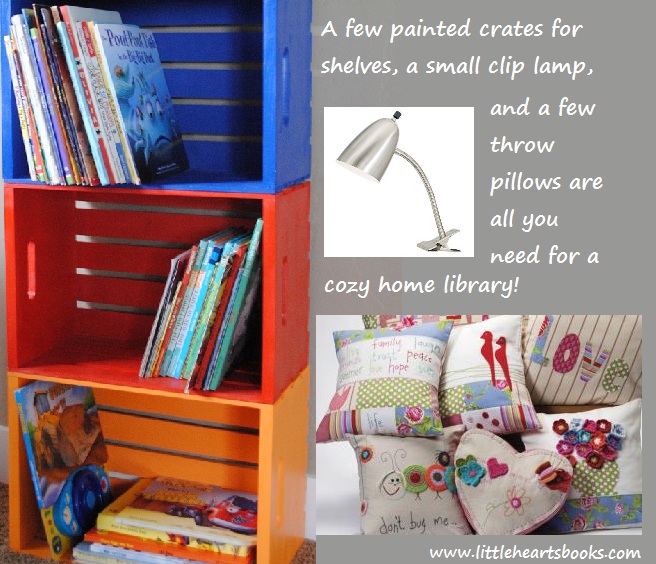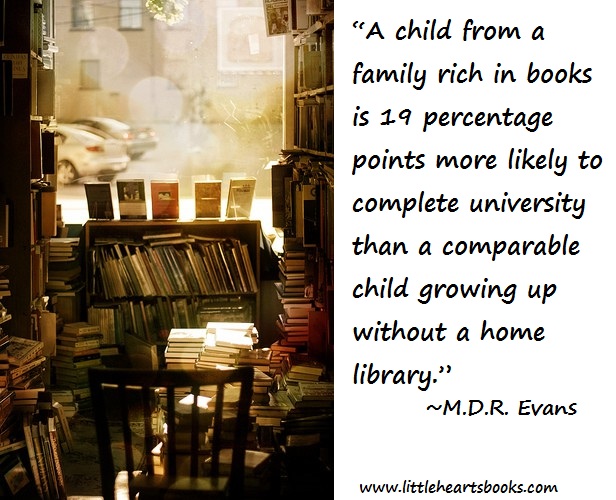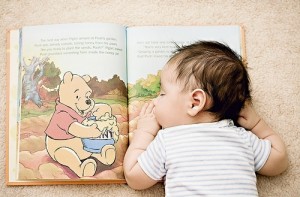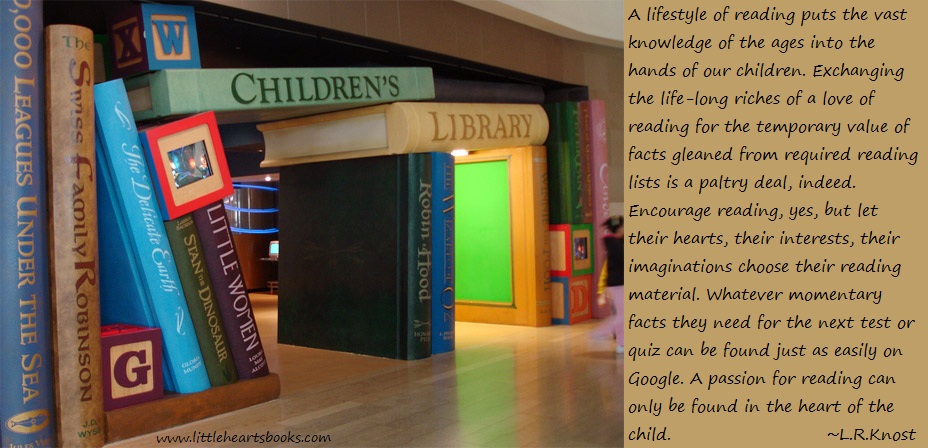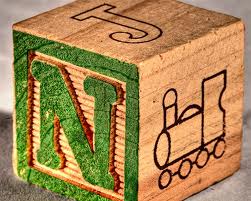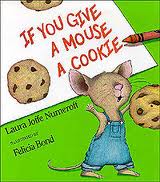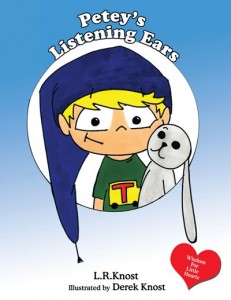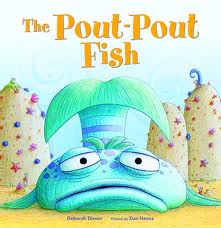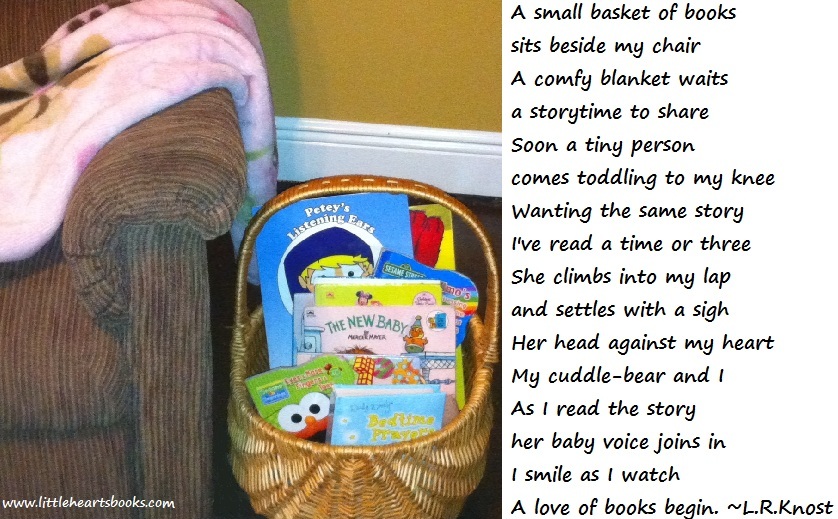When Children Hit~10 Tips for Parents
[Portions reprinted from The Gentle Parent: Positive, Practical, Effective Discipline by L.R.Knost. Two Thousand Kisses a Day: Gentle Parenting Through the Ages and Stages and Whispers Through Time: Communication Through the Ages and Stages of Childhood also available on Amazon and through other major retailers.]
 Toddlers and preschoolers are still in the early stages of learning to communicate verbally. Add to that the fact that they have little-to-no impulse control and very immature social skills, and you’ve got a recipe for an instinctive physical response (i.e. hitting, kicking, biting, hair pulling, throwing things, etc.) to situations in which they are frustrated, angry, scared, or just tired and out-of-sorts.
Toddlers and preschoolers are still in the early stages of learning to communicate verbally. Add to that the fact that they have little-to-no impulse control and very immature social skills, and you’ve got a recipe for an instinctive physical response (i.e. hitting, kicking, biting, hair pulling, throwing things, etc.) to situations in which they are frustrated, angry, scared, or just tired and out-of-sorts.
Many parents who practice gentle discipline wonder where their little one picked up the behavior, not realizing that it is a normal and age-appropriate reaction, albeit an unacceptable one. Very often parents are advised to spank their child to train them not to hit others, especially those who are smaller and weaker than they are. (more…)
 Award-winnning author, L.R.Knost, is the founder and director of the children's rights advocacy and family consulting group, Little Hearts/Gentle Parenting Resources, and Editor-in-Chief of Holistic Parenting Magazine. Books by L.R.Knost include Whispers Through Time: Communication Through the Ages and Stages of Childhood ; Two Thousand Kisses a Day: Gentle Parenting Through the Ages and Stages ; The Gentle Parent: Positive, Practical, Effective Discipline ; and Jesus, the Gentle Parent: Gentle Christian Parenting the first four books in the Little Hearts Handbook gentle parenting series, and children’s picture books Petey’s Listening Ears and the soon-to-be-released Grumpykins series.
Award-winnning author, L.R.Knost, is the founder and director of the children's rights advocacy and family consulting group, Little Hearts/Gentle Parenting Resources, and Editor-in-Chief of Holistic Parenting Magazine. Books by L.R.Knost include Whispers Through Time: Communication Through the Ages and Stages of Childhood ; Two Thousand Kisses a Day: Gentle Parenting Through the Ages and Stages ; The Gentle Parent: Positive, Practical, Effective Discipline ; and Jesus, the Gentle Parent: Gentle Christian Parenting the first four books in the Little Hearts Handbook gentle parenting series, and children’s picture books Petey’s Listening Ears and the soon-to-be-released Grumpykins series.
Picky Eater? Here’s Help!
[Reprinted from Two Thousand Kisses a Day: Gentle Parenting Through the Ages and Stages by L.R.Knost. Whispers Through Time: Communication Through the Ages and Stages of Childhood and The Gentle Parent: Positive, Practical, Effective Discipline also now available on Amazon and through other major retailers.]
~~~~~~~~~~~~~~~~~~~~~
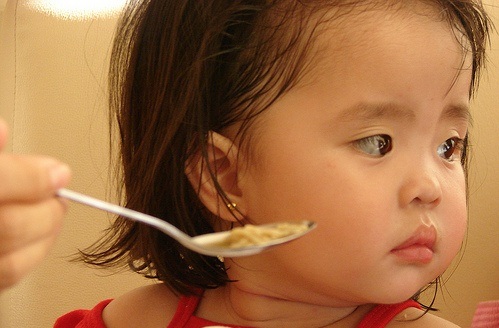 I was one of those children who was incredibly picky when it came to food and, despite my mom’s gently enforced ‘one bite rule,’ I went on to become an incredibly picky eater as an adult, as well. I vividly remember as a young child gagging as I tried to force down a bite, my throat feeling like it was closing up, and like there was no way food was going to fit through there. As a very compliant child, it bothered me immensely to disappoint my mom, and, being the logical person that I was even at that young age, I remember feeling that her expectations were very reasonable and being frustrated at my own inability to comply.
I was one of those children who was incredibly picky when it came to food and, despite my mom’s gently enforced ‘one bite rule,’ I went on to become an incredibly picky eater as an adult, as well. I vividly remember as a young child gagging as I tried to force down a bite, my throat feeling like it was closing up, and like there was no way food was going to fit through there. As a very compliant child, it bothered me immensely to disappoint my mom, and, being the logical person that I was even at that young age, I remember feeling that her expectations were very reasonable and being frustrated at my own inability to comply.
Fast forward a few years to when I began having children of my own and needed to make parenting decisions about everything from breastfeeding to cosleeping to discipline. On my journey to gentle parenting I revisited my childhood memories often, finding myself appreciating my mom’s gentleness and her way of using silliness to help me see the ‘silver lining’ in life when things were hard. In some things, I chose to follow the parenting path my mom took, and in others I took a different course and blazed my own trail.
When I was at university, I worked as a certified nutrition consultant with a focus on natural approaches to nutrition, health, and fitness. I took that knowledge, along with my studies in developmental psychology, human behavior, and communication, and incorporated all of it into my parenting decisions.
As I muddled through the toddler years with my firstborn, I decided to take an approach to nutrition that was unheard of, as far as I knew. I would offer to nurse, offer the food on my plate, and offer food I’d made specifically for him, and then let my little man decide. That was the beginning of our baby led weaning, though I didn’t know that term at the time.
What I discovered then and have seen proven time and again through the years with my own six very different children as well as with the families I’ve worked with is that, given the freedom to choose, children will generally experiment with more textures and tastes than if they are forced to eat their parents’ choice of food for them. It’s simply human nature that, if a child (or an adult, for that matter!) knows that they don’t have to try a new food and that they can run to the trashbin and spit it out if they do try it and don’t like it, then they are far, far more likely to give it a chance. And if they don’t try it the first time it’s offered, or if they do try it and don’t like it, making it available again off and on in the future will give them more opportunities to try the food and perhaps end up liking it when their tastes mature a bit more.
In our home, my children know that if they don’t like what’s being served for a meal there is always an alternative in the form of a PB&J or a reheat later if they just aren’t hungry at mealtime, though if we’re sitting down together I do expect them to sit with the family and chat with us while we eat. Even if they like the food being served, they may not feel hungry for a heavy meal just then or perhaps the last time they ate that meal their tummy got upset or maybe there are other reasons they don’t want the meal that they simply can’t articulate. As the adult, I can choose to make an issue out of it and end up in an unnecessary power struggle, or I can choose to offer my children the same respect I offer myself, because you can bet your bottom dollar that if I don’t want to eat something, I’m not eating it!
Among the many benefits of this approach, beyond the greater propensity for a child to experiment with tastes and textures and beyond the elimination of mealtime battles, I also saved myself a ton of mommy guilt through the years. I had no way of knowing early on that my renaissance girl had Sensory Processing Disorder which was strongly affecting her ability to eat or that my little caboose was missing an enzyme and couldn’t eat meat. Had I spent their toddler years forcing foods on them and engaging in coercive or punitive mealtime parenting, the damage to our relationship, not to mention their health, could have been disastrous. Additionally, children who feel powerless over their lives can begin trying to recapture a sense of power by exercising excessive control over their eating with the danger of a resulting eating disorder when they get into their teen years.
So, on a practical level how do you get a toddler or preschooler to eat? Well, first and foremost, rigidly scheduling mealtimes creates a battleground in and of itself. Toddlers’ and preschoolers’ ever-shifting growth patterns cause them to go through slow-growth periods where they simply aren’t hungry and other periods where they’re hungry 24/7! Grazing, or eating multiple small meals and snacks throughout the day, not only fits these growth patterns better, but is actually a much healthier way for all of us to eat because it stabilizes blood sugar which, when low, leads to overeating as does simply eating because ‘it’s time.’ Teaching our little ones to listen to their bodies’ hunger cues is a hugely positive step toward avoiding obesity later in life, as well!
Secondly, a combination of keeping little ones active so they work up a good appetite (which also sets them on the path toward an active physical lifestyle!) and offering a variety of healthy foods throughout the day will typically be all it takes to meet their nutrition requirements. As a general guideline, toddlers and preschoolers need:
- Two to three servings of dairy (i.e. 1 oz. cheese, ½ cup milk, ½ cup yogurt);
- Four to six servings of grains (i.e. ½ slice bread, ½ cup non-sugared cereal, ¼ cup pasta, 2 crackers);
- Two servings of protein (i.e. two 1” squares of chicken, fish, or beef);
- Two to three servings of veggies (i.e. 2 tbs peas, corn, cauliflower, etc);
- And two to three servings of fruit (i.e. ½ banana, apple, orange, etc., ¼ cup raisins, blueberries, raspberries, 3-4 strawberries or grapes, etc)
Here are some fun ways to invite your little ones to make healthy eating choices:
~Breakfast ideas~

- Need an easy and healthy breakfast for little ones? Try an ice cream cone filled with almonds & bite sized chunks of fruit & cheese!
- Start little people’s day healthy & happy. Make a smiley face clock on their plate with almonds, cheese & fruit with yogurt to dip them in!
- Try making ‘apple cookies’ (apples sliced into round discs) into faces with almonds, raisins & cheese!
- Sundae breakfast! Yogurt sprinkled with granola & raisins & nuts & drizzled with local honey (helps control seasonal allergies, too), yummy! *Note: Never feed honey to a baby under a year old.

- Here comes the sun! Make frozen pancakes more healthy by surrounding them with fruit & topping with berries & almonds & drizzling with local honey!
~Lunch ideas~

- Banana Boats~Slice of whole wheat bread spread with peanut butter & local honey & wrapped around a banana. Top with just a sprinkle of brown sugar for a treat!
- Double Trouble~Celery, carrot & pretzel sticks with a scoop of cottage cheese & a scoop of peanut butter for double dipping!
- Picasso PB&J’s~Round whole wheat flat bread with small dollops of peanut butter, fruit preserves & yogurt around the edge in a colorful palate with pretzel sticks for paint brushes!
~Dinner ideas~
- Boil some cauliflower, carrots, zucchini & yellow squash until a bit mushy & puree.
1) Mix with your favorite meatloaf recipe for a hidden veggie serving!
2) Mix with spaghetti sauce & freeze in single serving containers.

- Spaghetti Twisters~Make rotini noodles instead of spaghetti noodles for a cute ‘twist’ and add your special spaghetti sauce for a tornado of veggie goodness!
- Pizza Racers~Use rectangular flatbread & lightly coat with olive oil and broil for a couple of minutes to crisp it up, then add your souped-up spaghetti sauce & let your little ones top with mozzarella ‘racing stripes’ & pepperoni ‘racing tires’ for a super-charged dinner!

- Pureed cauliflower also works great mixed with mac & cheese, stuffing, and mashed potatoes for a hidden veggie to round out any meal!
Related posts:
Toddlers, Tantrums, and Time-Ins, Oh My!
Practical Gentle Discipline Guide
Tots to Teens~Communication Through the Ages and Stages
A Place to Rest~Becoming Your Child’s Safe Harbor
Love in the Time of Cosleeping
Your Baby isn’t Trying to Annoy You; He’s Trying to Communicate!
 Award-winnning author, L.R.Knost, is the founder and director of the children's rights advocacy and family consulting group, Little Hearts/Gentle Parenting Resources, and Editor-in-Chief of Holistic Parenting Magazine. Books by L.R.Knost include Whispers Through Time: Communication Through the Ages and Stages of Childhood ; Two Thousand Kisses a Day: Gentle Parenting Through the Ages and Stages ; The Gentle Parent: Positive, Practical, Effective Discipline ; and Jesus, the Gentle Parent: Gentle Christian Parenting the first four books in the Little Hearts Handbook gentle parenting series, and children’s picture books Petey’s Listening Ears and the soon-to-be-released Grumpykins series.
Award-winnning author, L.R.Knost, is the founder and director of the children's rights advocacy and family consulting group, Little Hearts/Gentle Parenting Resources, and Editor-in-Chief of Holistic Parenting Magazine. Books by L.R.Knost include Whispers Through Time: Communication Through the Ages and Stages of Childhood ; Two Thousand Kisses a Day: Gentle Parenting Through the Ages and Stages ; The Gentle Parent: Positive, Practical, Effective Discipline ; and Jesus, the Gentle Parent: Gentle Christian Parenting the first four books in the Little Hearts Handbook gentle parenting series, and children’s picture books Petey’s Listening Ears and the soon-to-be-released Grumpykins series.
Death of a Butterfly: Helping Children Cope with Loss

[Reprinted from Two Thousand Kisses a Day: Gentle Parenting Through the Ages and Stages by L.R.Knost. Whispers Through Time: Communication Through the Ages and Stages of Childhood and The Gentle Parent: Positive, Practical, Effective Discipline also now available on Amazon and through other major retailers.]
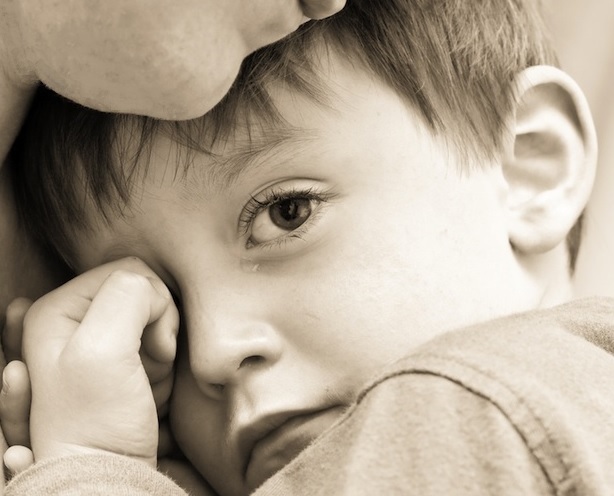 My little Funny Face accidentally killed a butterfly today. Her sweet little heart is broken, poor thing. We’re walking through the stages of mourning together as I use these small (to us adults) losses to equip her with healthy tools for handling the difficult things life will surely bring through the years, as it does to all of us. Whether it’s the death of a butterfly, the loss of a favorite stuffed animal, or another loss that matters to them deeply, guiding children through their uncomfortable and often overwhelming emotions is something parents are often unprepared to handle. Here are the steps we take together when life gets hard and loss becomes a reality to my children:
My little Funny Face accidentally killed a butterfly today. Her sweet little heart is broken, poor thing. We’re walking through the stages of mourning together as I use these small (to us adults) losses to equip her with healthy tools for handling the difficult things life will surely bring through the years, as it does to all of us. Whether it’s the death of a butterfly, the loss of a favorite stuffed animal, or another loss that matters to them deeply, guiding children through their uncomfortable and often overwhelming emotions is something parents are often unprepared to handle. Here are the steps we take together when life gets hard and loss becomes a reality to my children:
1.) Feeling~The first step is simply allowing my children to feel their emotions. If they’re crying, I listen to their cues to know when to offer hugs or if they need some time alone or just someone to sit quietly next to them. If they’re angry, I watch closely to see if they need some directions for a safe outlet such as punching a pillow or going outside to kick a ball or if they are able to just stomp around and get it out that way. If they are unnaturally quiet, I let them know I’m there if they need me and then I leave them alone to sort through their emotions in their own time.
2.) Expressing~The second step is guiding my children to express their feelings in some tangible form. This step begins either when they initiate a conversation about the loss or when I see that their emotions are getting the best of them, indicating that they need some assistance in moving forward. This step may take the form of simply talking through what they are feeling, but typically it includes drawing a picture, making up a song or dictating a poem for me to write down for them, making a memory box, or some combination of each of them.
3.) Refocusing~The third and last step is giving my children ideas about how to move on. It’s often hard for them to figure out how to redirect their thoughts from constantly swirling around their loss. It takes a measure of mental maturity to be able to focus elsewhere when emotions are running high. This is not to say that they should never think about their loss again. I am always open to listening to their feelings and sharing their memories with them. This last step is just gently helping them to consciously shift their attention from what they have lost to what they still have, moving their thoughts from loss to life. This step often takes the form of encouraging them to head outside and play in the mud or climb a tree, or it might be offering to read them a favorite book or play a board game with them or maybe inviting a friend over to play.
While these three steps are in no way exhaustive, the idea behind this process is to simplify the stages of grief in a way that is accessible to parents and understandable to children. And then, when life hits hard and big losses occur such as the loss of a loved one, divorcing parents, etc. having walked through these small losses with our children sets the stage for helping them to work through the harder things while preserving a healthy parent/child connection.
When big life losses do occur, staying in tune with our children and letting them ask questions freely while we work to temper our answers in age appropriate terms is vital. Watching for changes in their behavior helps to give us clues as to what they’re feeling. If they start having trouble sleeping or resisting going to school or having meltdowns, etc. it might be helpful to seek out professional counseling for a brief time. We also need to keep in mind that small children have active imaginations and the line between fantasy and reality is very blurry for them. Death may not impact them much at all if the reality of it doesn’t sink in, or, on the flip side it could have a significant impact and they could begin to imagine all sorts of awful things happening to them or their family or friends. It’s important to let our children lead the way as to how we need to help them cope. Our local library or online at Goodreads or Amazon’s Listopia can also be good resources for age appropriate books on death and grief to share with our children. We do need to be sure to read through them ourselves first to make sure we’re comfortable with how things are presented, though.
Here is a brief, generic ‘script’ that can be used as a starting point for sharing difficult news about a loss with our children:
“I have something to tell you, and it’s a very hard thing. I want you to know that you are safe, and I’m safe, and I’m right here to help you, okay?”
(Give them time to respond.)
“Your (grandpa, aunt, friend, etc.), *name,* died. Do you know what ‘died’ means?”
(Give them time to respond.)
“It means they’re gone to (fill in your belief), and they won’t be coming back.”
(Give them time to respond.)
“It’s okay to be sad or even angry or scared. Those are normal emotions when people die. We are all very sad because we’re going to miss *name.*”
(Give them time to respond.)
“You’ll probably need some time to think about what happened, and you’ll probably have questions. That’s okay. And it’s okay to talk about *name,* too. We all are going to miss *name* and talking about them can help us to remember happy times with them.”
(Give them time to respond.)
“Would you like to make a goodbye card or a memory box? That might help you to feel better.”
Obviously this is a generic script that will need to be adapted based on a child’s responses, but it provides a starting point to open the conversation and begin to walk them through the grieving and healing process. Time does heal, but often it isn’t simply the passage of time that heals, but rather the support and comfort from those with whom we spend that time.
Related posts:
Children in the three to six-year-old age range are beginning to realize that their parents aren’t the all-powerful beings that they once believed them to be. This realization can be very uncomfortable for them, causing them a great deal of unease as they are concurrently beginning to realize that there is a whole, big, wide world beyond their safe, little home, a that the world is full of potential dangers, hazards unknown, and just a lot of really big, scary things. So what is a parent to do with their newly timid little house-mouse? The Age of Fear~Young Children and Anxiety
 Award-winnning author, L.R.Knost, is the founder and director of the children's rights advocacy and family consulting group, Little Hearts/Gentle Parenting Resources, and Editor-in-Chief of Holistic Parenting Magazine. Books by L.R.Knost include Whispers Through Time: Communication Through the Ages and Stages of Childhood ; Two Thousand Kisses a Day: Gentle Parenting Through the Ages and Stages ; The Gentle Parent: Positive, Practical, Effective Discipline ; and Jesus, the Gentle Parent: Gentle Christian Parenting the first four books in the Little Hearts Handbook gentle parenting series, and children’s picture books Petey’s Listening Ears and the soon-to-be-released Grumpykins series.
Award-winnning author, L.R.Knost, is the founder and director of the children's rights advocacy and family consulting group, Little Hearts/Gentle Parenting Resources, and Editor-in-Chief of Holistic Parenting Magazine. Books by L.R.Knost include Whispers Through Time: Communication Through the Ages and Stages of Childhood ; Two Thousand Kisses a Day: Gentle Parenting Through the Ages and Stages ; The Gentle Parent: Positive, Practical, Effective Discipline ; and Jesus, the Gentle Parent: Gentle Christian Parenting the first four books in the Little Hearts Handbook gentle parenting series, and children’s picture books Petey’s Listening Ears and the soon-to-be-released Grumpykins series.
The Age of Fear: 8 Tips to Help Young Children Cope with Anxiety
[Reprinted from Two Thousand Kisses a Day: Gentle Parenting Through the Ages and Stages by L.R.Knost. Whispers Through Time: Communication Through the Ages and Stages of Childhood and The Gentle Parent: Positive, Practical, Effective Discipline also now available on Amazon and through other major retailers.]
Your once fearless five-year-old suddenly refuses to leave your side at the park saying, “I’m afraid the birds will eat me,” while eyeing the tiny swallows hopping on the ground as if they’re evil geniuses plotting his demise.
Your three-year-old, whom you once found proudly grinning while sitting atop the refrigerator, has abruptly decided the swings are objects of abject terror that will, “Fly me to the ground.” (Translation: I’ll fall off!)
Your six-year-old who has slept like a log in his own bed for years is suddenly resisting bedtime and climbing into your bed with you at 3 am every. single. night.
Your happy little four-year-old suddenly becomes withdrawn and clingy, refusing to play with her playdate friends and wanting to sit in your lap. And, even worse, she’s started sucking her thumb again!
The preschool and early elementary school years are sometimes marred with exaggerated fears, odd anxieties, nightmares, night terrors, and other evidences of insecurity that can make the most confident of parents feel a combination of dismay, frustration, worry, and failure. Regression is a common accompaniment, from pottying accidents to night-waking to thumb-sucking. Often, acting-out behaviors also increase in this time period.
So, what in the world is going on?
No, it’s not an environmental-toxin-induced, super-early-onset of adolescent-hormone-overload. And, normally, it’s not a trauma-reaction to life changes such as moving or starting preschool or school, though those events can exacerbate the issue. (Be aware that these behaviors can, rarely, indicate an anxiety disorder, stress-overload, or abuse. If you suspect any of these things may be causing your child’s behavior, seek a professional evaluation.)
Typically, though, sudden anxiety behaviors in preschool/early elementary aged children are simply another normal stage of development, an indication of cognitive growth. In other words, as odd as it sounds, fear can be a sign of maturity!
Children in the three to six-year-old age range (Keep in mind that this is a rough age estimate. Children are individuals, not pre-programmed robots!) are beginning to realize that their parents aren’t the all-powerful beings that they once believed them to be. This realization can be very uncomfortable for them, causing them a great deal of unease as they are concurrently beginning to realize that there is a whole, big, wide world beyond their safe, little home, and that that world is full of potential dangers, hazards unknown, and just a lot of really big, scary things.
So what is a parent to do with their newly timid little house-mouse?
First, be aware that there is no one-size-fits-all miracle ‘cure.’ You know your child better than anyone else, and being responsive to her unique needs means taking your cues from her as to what may help or hinder her journey through this uncomfortable stage.
That said, here are some ideas that may help:
- Before forcing your child to ‘face his fears,’ consider whether someone throwing a spider on you if you are deathly afraid of spiders or locking you in a closet if you’re claustrophobic would be helpful to you in overcoming your fears. If the answer is ‘NO!’ then honor your child’s feelings and move on to another solution.
- When your child voices her concerns, resist the urge to minimize them. If she says, “I’m afraid of monsters coming in my window,” try not to say, “There’s no such thing as monsters.” Remember, she’s realizing you aren’t all-powerful, and that means you aren’t all-knowing, either! Rather than be reassured by your words, she’ll simply think you don’t know about the monsters and can’t help her and keep her safe. Instead, you can brainstorm ideas together to keep the monsters at bay. While you don’t want to say that monsters actually do exist, you can say something like, “Let’s think of ways to keep you safe. What if daddy throws the monsters away in the trashcans outside and the trashman takes them away?” Don’t be afraid to be seriously silly. In other words, take her fears seriously, but offer silly solutions that offer visuals of the monsters (or whatever the fear is) going away forever.
- Help your child to make a ‘nightmare safe’ out of a shoe box. At night
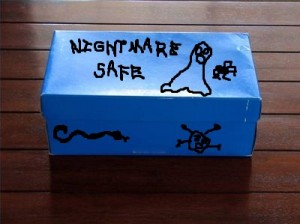 before he goes to bed, sit with him and encourage him to put all his scary thoughts in the box for you to take and keep safely away from him while he sleeps. Let him know that if he does have a bad dream, he can come to you even if it’s the middle of the night, and you’ll help him to put the scary dream in the box so he’ll be able to go back to sleep.
before he goes to bed, sit with him and encourage him to put all his scary thoughts in the box for you to take and keep safely away from him while he sleeps. Let him know that if he does have a bad dream, he can come to you even if it’s the middle of the night, and you’ll help him to put the scary dream in the box so he’ll be able to go back to sleep.
- Avoid phrases such as “You’re a big boy now” and “Only babies do that.” Focus instead on encouraging your child to do the things you know he can do. For instance, if he’s usually able to climb the ladder on the slide but gets ‘stuck’ halfway up and asks for help, start by moving near so he knows you are close and willing to help him if needed. Then verbally encourage him, “I know you can do it. I’m here if you need me.” But don’t pressure him. If he gets upset or insists he can’t do it, help him down. Remember, it isn’t really about the slide at all. It’s about seeking reassurance that you can still be trusted to take care of him, that he’s still safe with you.
-
 If the occasional monster in the closet or under the bed needs to be evicted, try reading a book like Go Away, Big Green Monster! and make your own ‘Monster-Away Spray,’ to send all the scary monsters packing. The ones we made didn’t match the colors in the book perfectly because we just used foam stickers and googlie eyes from our craft box and blue spray bottles from the bargain bin at the fabric store, but my girls were thrilled with them. We filled them with water (and added a little spritz of febreeze in my six-year-old’s bottle because, “Monsters can’t STAND flowers!”) and then Daddy and Big Brother took turns pretending to be monsters and ran away squealing from the girls when they got sprayed. Role-playing with children (and just playing with them, period!) is a powerful tool in helping them learn coping skills. Now, a bit of bedtime spritzing in closets and under beds is all it takes to make my girls feel confident that they’ve rousted the beasties so they can sleep in peace!
If the occasional monster in the closet or under the bed needs to be evicted, try reading a book like Go Away, Big Green Monster! and make your own ‘Monster-Away Spray,’ to send all the scary monsters packing. The ones we made didn’t match the colors in the book perfectly because we just used foam stickers and googlie eyes from our craft box and blue spray bottles from the bargain bin at the fabric store, but my girls were thrilled with them. We filled them with water (and added a little spritz of febreeze in my six-year-old’s bottle because, “Monsters can’t STAND flowers!”) and then Daddy and Big Brother took turns pretending to be monsters and ran away squealing from the girls when they got sprayed. Role-playing with children (and just playing with them, period!) is a powerful tool in helping them learn coping skills. Now, a bit of bedtime spritzing in closets and under beds is all it takes to make my girls feel confident that they’ve rousted the beasties so they can sleep in peace!
- If regression is an issue, keep in mind that your child is self-comforting by returning to a time she felt safe. Rather than punishing, ridiculing, bribing, or in other ways trying to ‘control’ the behavior, offer comfort in appropriate ways to demonstrate that she can trust you to meet her comfort/safety needs. This applies to acting-out behaviors, as well. Set boundaries, certainly, and provide plenty of guidance, but remember that punishment tends to push children farther away rather than connecting with them. Since your child is reacting to a feeling of disconnection from you in her new understanding of your non-superhero status, pushing her further away will merely exacerbate the issue, not solve it.
- Just listen. This is the simplest solution to a rather complex problem. Slow down and make time to just take a walk with your child. Sit with him in the evening and watch him color or play a quiet board game with him. Lay with him in his bed for a few minutes before he sleeps and chat about the day. Just the fact of you taking the time to focus on him, to be quiet with him, to enjoy his company, and to reconnect with him will go a long way towards soothing his fears.
- Even if your child isn’t introverted by nature, the following table offers some wonderful tips that translate well into this brief anxiety stage:
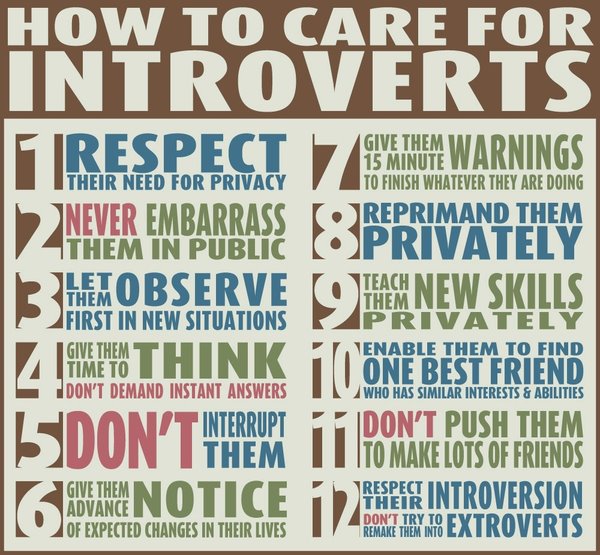
Remember, just like all the other stages of development, this ‘age of fear’ won’t last forever. Staying connected with your child and keeping the communication lines open through the ages and stages of development will help to ease their way as well as keeping your relationship strong and healthy.
Related posts:
Toddlers, Tantrums, and Time-Ins, Oh My!
Testing the Boundaries~What’s A Parent To Do?
To a Toddler Sharing is a 4 Letter Word~MINE!
Babes and Boundaries~A Gentle Parenting Perspective
Your Baby isn’t Trying to Annoy You; He’s Trying to Communicate!
 Award-winnning author, L.R.Knost, is the founder and director of the children's rights advocacy and family consulting group, Little Hearts/Gentle Parenting Resources, and Editor-in-Chief of Holistic Parenting Magazine. Books by L.R.Knost include Whispers Through Time: Communication Through the Ages and Stages of Childhood ; Two Thousand Kisses a Day: Gentle Parenting Through the Ages and Stages ; The Gentle Parent: Positive, Practical, Effective Discipline ; and Jesus, the Gentle Parent: Gentle Christian Parenting the first four books in the Little Hearts Handbook gentle parenting series, and children’s picture books Petey’s Listening Ears and the soon-to-be-released Grumpykins series.
Award-winnning author, L.R.Knost, is the founder and director of the children's rights advocacy and family consulting group, Little Hearts/Gentle Parenting Resources, and Editor-in-Chief of Holistic Parenting Magazine. Books by L.R.Knost include Whispers Through Time: Communication Through the Ages and Stages of Childhood ; Two Thousand Kisses a Day: Gentle Parenting Through the Ages and Stages ; The Gentle Parent: Positive, Practical, Effective Discipline ; and Jesus, the Gentle Parent: Gentle Christian Parenting the first four books in the Little Hearts Handbook gentle parenting series, and children’s picture books Petey’s Listening Ears and the soon-to-be-released Grumpykins series.
To a Toddler Sharing is a 4 Letter Word~MINE!
[Reprinted from Two Thousand Kisses a Day: Gentle Parenting Through the Ages and Stages by L.R.Knost. Whispers Through Time: Communication Through the Ages and Stages of Childhood and The Gentle Parent: Positive, Practical, Effective Discipline also now available on Amazon and through other major retailers.]
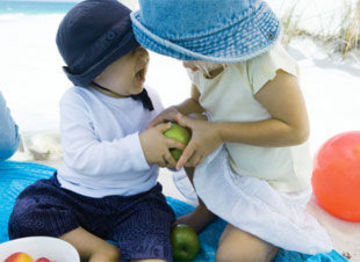 Almost from the moment a baby is born, parents teach them not to share. “No, no, sweetie. That’s mommy’s” and “That’s daddy’s, not yours” accompanied by the removal of whatever the forbidden item is are daily realities for little ones. This is unavoidable, of course, since bacteria-ridden keys don’t belong in little mouths and iphones don’t work well when soaked in drool.
Almost from the moment a baby is born, parents teach them not to share. “No, no, sweetie. That’s mommy’s” and “That’s daddy’s, not yours” accompanied by the removal of whatever the forbidden item is are daily realities for little ones. This is unavoidable, of course, since bacteria-ridden keys don’t belong in little mouths and iphones don’t work well when soaked in drool.
But the challenge comes when our little ‘reflectors’ are expected to share their toys with anyone and everyone who takes a liking to them. (Keep in mind that “their toys” as defined by a toddler are anything they own, are playing with, want to play with, don’t want to play with but want to remain available, etc.) It’s fully acceptable for us adults to not share our ‘toys’ with others, though. How often do we invite friends over and hand them the keys to our car? And yet we get to choose our own friends, do the inviting, and we have adult reasoning skills and judgment in place…things small children don’t have control over or access to!
The primary learning mode for little ones is imitation, but still we expect them to somehow have the cognitive maturity to learn to share despite their parents not sharing their ‘toys’ with them and despite seeing their parents not sharing their ‘toys’ with their own friends.
On top of that, we’re expecting them to grasp some pretty intricate and tricky relational nuances. What does ‘being a good friend’ entail? Why is someone taking something I want an acceptable part of friendship? If they can take what I want, why can’t I take what they want?
And, to round off the difficulty, ownership is an advanced, abstract concept and sharing is even more so. The difference between sharing and giving away forever or between someone borrowing your things and someone stealing from you is rather nebulous in the mind of a child. Now add in a complete inability to grasp time concepts (They get my toy for a minute? How long is a minute? When mommy tells me ‘just a minute’ when she’s on the phone it seems like forever before she’s done!) and to understand other abstract concepts such as permanence, and you can see the murky waters tiny people are expected to navigate when it comes to understanding sharing!
Obviously, little ones need help overcoming all of these obstacles. Punishing them, calling them selfish brats, forcing them to share, etc. are all counterproductive, not to mention damaging to the very relationship that is pivotal to eventual understanding of the concept of sharing. Going back to that primary learning mode of imitation, the key to teaching a child to share lies in the trust relationship being built by gentle, responsive parenting:
1.) When a child is secure in their relationship with their parents, when they know they will be heard, when they trust that their needs will be met quickly and consistently, much of the impetus behind the refusal to share is removed simply because the child isn’t living in a constant state of ‘fight or flight’ response. (This is not to say they will share freely, no matter how gentle the parenting. The afore mentioned obstacles are still in play, and your little ones are still human. What it does mean is that some of the impediments to sharing are removed and the stage is set for learning.)
2.) Within the context of the parent/child relationship, be mindful of how often you say ‘no’ or ‘mine’ and try to offer alternatives in the moment to model sharing.
3.) Be aware of the fact that your child isn’t choosing their own friends at this point and neither they nor their little playmates are skilled socially yet. Stay nearby and in tune with your little one so you can step in and help them deal with any sharing difficulties such as snatching or tug-o-war with a toy before they escalate.
4.) Use concrete words to guide your little one in social situations. For example, try “Use your gentle hands” instead of “Don’t snatch/hit/push.”
5.) Resist the embarrassed-adult-knee-jerk-reaction of scolding your child, snatching toys from them to give to another child, and punishing your child for a normal developmental stage. That kind of reaction not only doesn’t model self-control, but it also doesn’t model acceptable social behavior, which is exactly what you’re upset about your child not displaying!
6.) Prepare for playdates by putting away any treasured toys such as special lovies or new toys that you know your little one will have trouble sharing. Honoring their feelings about these few special things will help them to feel more comfortable sharing their other toys because you are showing them in a concrete manner that you will help them to protect and preserve the things that matter to them.
7.) Play sharing games with your child daily to practice this advanced skill. When she says “Mine!” respond by smiling, picking up something of yours you don’t mind her playing with, and saying, “This is mine. I’ll share!” and hand it to her. Often little ones will start running around picking up their toys and bringing them to you to ‘share’ and wait for it to be reciprocated, resulting in a back and forth, back and forth sharing game that taps into another excellent learning mode for children…play!
Above all, keep in mind that sharing is a learned skill and it will take time for your  small one to grow into a socially skilled little butterfly. Creating an atmosphere of trust, modeling sharing, and honoring their feelings will surround them with a safe environment in which they can develop the skills needed to become the most treasured of friends!
small one to grow into a socially skilled little butterfly. Creating an atmosphere of trust, modeling sharing, and honoring their feelings will surround them with a safe environment in which they can develop the skills needed to become the most treasured of friends!
Related posts:
Toddlers, Tantrums, and Time-Ins, Oh My!
Testing the Boundaries~What’s A Parent To Do?
Babes and Boundaries~A Gentle Parenting Perspective
Your Baby isn’t Trying to Annoy You; He’s Trying to Communicate!
 Award-winnning author, L.R.Knost, is the founder and director of the children's rights advocacy and family consulting group, Little Hearts/Gentle Parenting Resources, and Editor-in-Chief of Holistic Parenting Magazine. Books by L.R.Knost include Whispers Through Time: Communication Through the Ages and Stages of Childhood ; Two Thousand Kisses a Day: Gentle Parenting Through the Ages and Stages ; The Gentle Parent: Positive, Practical, Effective Discipline ; and Jesus, the Gentle Parent: Gentle Christian Parenting the first four books in the Little Hearts Handbook gentle parenting series, and children’s picture books Petey’s Listening Ears and the soon-to-be-released Grumpykins series.
Award-winnning author, L.R.Knost, is the founder and director of the children's rights advocacy and family consulting group, Little Hearts/Gentle Parenting Resources, and Editor-in-Chief of Holistic Parenting Magazine. Books by L.R.Knost include Whispers Through Time: Communication Through the Ages and Stages of Childhood ; Two Thousand Kisses a Day: Gentle Parenting Through the Ages and Stages ; The Gentle Parent: Positive, Practical, Effective Discipline ; and Jesus, the Gentle Parent: Gentle Christian Parenting the first four books in the Little Hearts Handbook gentle parenting series, and children’s picture books Petey’s Listening Ears and the soon-to-be-released Grumpykins series.
Play~Bubbles and Babies and Butterflies
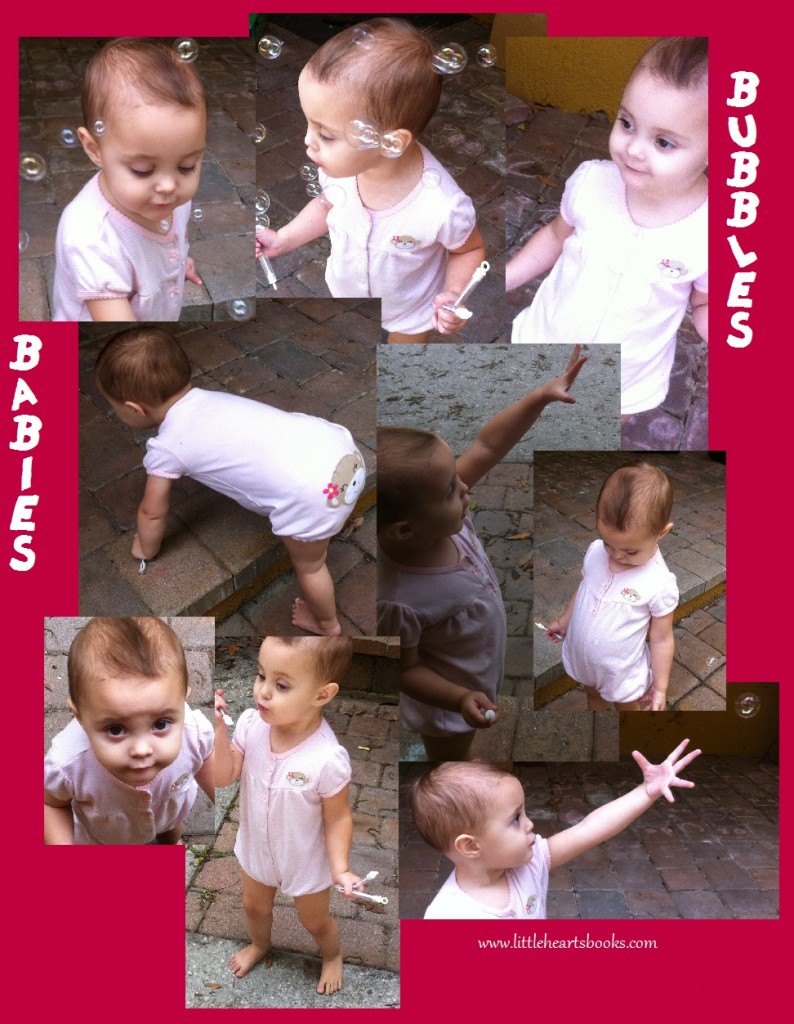 Sunshiny days fly on butterfly wings
Sunshiny days fly on butterfly wings
Filled with wading pools, sidewalk chalk, springy-time things
Bubbles and babies and bear-bottomed rompers
Mudpies and magpies and jump-rope trick jumpers
Swinging and sliding and climbing and running
Learning, discovering, growing, becoming
No time to waste they are seizing the day
The work of a child is simply to play

Related posts:
On a Winnie the Pooh style ‘long explore’ my little Pooh Bear discovered the world in The Many Adventures of My Little Pooh Bear
Children who love to read…READ! Engaging children’s hearts in the wonder of reading instead of just training their minds in its mechanics. Raising Bookworms
Think homeschooled children are unsocialized, over-controlled, locked-away-from-the-world misfits? Think again! My Renaissance Girl
In the world of a child wonders are as simple as sticks and sheets, leaves and books, boxes and giggles, and the promise in a rainy day. The Seven Wonders of the World of Childhood
There is such a rush these days to get children sleeping through the night, weaned off the breast, eating solid foods, potty trained, reading independently, and on and on, that we seem to have lost the ability to simply enjoy life as it happens and let our children do the same. A Return to Childhood
Parenting choices strongly impact the level and type of attachment a child develops and, by extension, the development of a love of learning. A love of learning grows when it isn’t stifled by fear or stress or regimented by over-structuring or a focus on achievement or competition. Parents fostering a healthy attachment are thus also fostering a life-long love of learning in their children. Live to Play~Play to Learn~Learn to Live!
Successful reading means far more than possessing the ability to read. Engaging the hearts of students moves reading success beyond a life skill and turns it into a life style. And graphic novels are too powerful of a tool in our arsenal to be disregarded because of pride or prejudice. Raising Super Readers~The MARVELous Power of Comic Books!
If you give a toddler a book
He’ll climb into your lap
While he’s in your lap
He might lay his head on your chest
When he lays his head on your chest
He’ll hear your heartbeat
When he hears your heartbeat
He’ll probably ask if you can hear…
 Award-winnning author, L.R.Knost, is the founder and director of the children's rights advocacy and family consulting group, Little Hearts/Gentle Parenting Resources, and Editor-in-Chief of Holistic Parenting Magazine. Books by L.R.Knost include Whispers Through Time: Communication Through the Ages and Stages of Childhood ; Two Thousand Kisses a Day: Gentle Parenting Through the Ages and Stages ; The Gentle Parent: Positive, Practical, Effective Discipline ; and Jesus, the Gentle Parent: Gentle Christian Parenting the first four books in the Little Hearts Handbook gentle parenting series, and children’s picture books Petey’s Listening Ears and the soon-to-be-released Grumpykins series.
Award-winnning author, L.R.Knost, is the founder and director of the children's rights advocacy and family consulting group, Little Hearts/Gentle Parenting Resources, and Editor-in-Chief of Holistic Parenting Magazine. Books by L.R.Knost include Whispers Through Time: Communication Through the Ages and Stages of Childhood ; Two Thousand Kisses a Day: Gentle Parenting Through the Ages and Stages ; The Gentle Parent: Positive, Practical, Effective Discipline ; and Jesus, the Gentle Parent: Gentle Christian Parenting the first four books in the Little Hearts Handbook gentle parenting series, and children’s picture books Petey’s Listening Ears and the soon-to-be-released Grumpykins series.
The Many Adventures of My Little Pooh Bear
“There is nothing that human beings do, know, think, hope, and fear that has not been attempted, experienced, practiced, or at least anticipated in children’s play.”~Heidi Britz-Crecelius
As A.A.Milne wrote in The Many Adventures of Winnie the Pooh, we went on a long ‘explore’ the other day simply because “It was a drowsy summer [well, actually, spring] afternoon, and the Forest was full of gentle sounds…”
My poor little Pooh Bear has been sick for weeks now, and I’ve been taking her out in the sunshine for a daily dose of vitamin D and fresh air to supplement her traditional medicines. On this particular day, which just happened to be the first day of spring, I played the role of adoring paparazzi and just snapped picture after picture as my little explorer wandered here and there at her own toddling pace. Looking over the myriad of pictures later was educational…for me!
My little explorer studied…
Light and Shadow as she danced with her shadow…
and moved leaves back and forth, back and forth from sun to shade and back again.
Texture as she went from the wooden foot bridge to the concrete and studied the hard and soft, the rough and smooth, the cold and warm.
Physics as she threw leaves into the breeze and discovered how the small ones fluttered away and the big ones fell unless she crumpled them into smaller pieces.
Directionality as she put leaves over the railing, through the railing, and under the railing.
And so much more, all in a supervised, but undirected day of play!

“Sometimes, if you stand on the bottom rail of a bridge and lean over to watch the river slipping slowly away beneath you, you will suddenly know everything there is to be known.”~A.A.Milne
Studies are confirming what early childhood education experts have known for years…Formal instruction can interfere with a preschooler’s creativity and problem-solving skills. A.A.Milne clearly understood that fact long ago when he included this thought-provoking dialogue in his classic children’s picture book,
“Rabbit’s clever,” said Pooh thoughtfully.
“Yes,” said Piglet, “Rabbit’s clever.”
“And he has a Brain.”
“Yes,” said Piglet, “Rabbit has a Brain.”
There was a long silence.
“I suppose,” said Pooh, “that that’s why he never understands anything.”
Gail Connel of Moving Smart puts it this way, “When we say ‘learning’ we actually mean ‘understanding,’ described by Merriam-Webster as ‘to grasp the meaning of.'” She goes on to give an example:
“Point to the top of your head, then point to the top of your toe. You pointed in two completely different directions. So what does ‘top’ mean? And if ‘top’ is in both of those places, then where is the top of the page?
Only after learning ‘top’ in many different ways will they begin to understand that ‘top’ is more than a location, it’s a concept. And to do that, they must experience it – literally and physically — by pointing to the top, touching the top, crawling along the top, running to the top, reaching the top, and on and on. And while they’re doing that, your use of the word ‘top’ helps them associate what they’re doing with what it’s called.
LANGUAGE + EXPERIENCE = UNDERSTANDING”

“Promise me you'll always remember: You're braver than you believe, and stronger than you seem, and smarter than you think.”~A.A.Milne
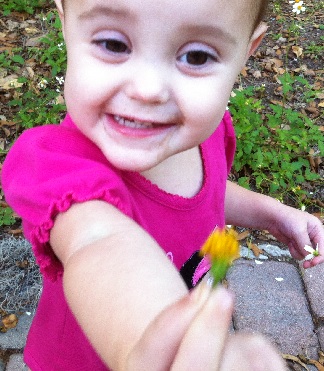
“Yesterday is history, tomorrow is a mystery, but today is a gift. That's why we call it the present." ~Winnie the Pooh
Related posts:
Children who love to read…READ! Engaging children’s hearts in the wonder of reading instead of just training their minds in its mechanics. Raising Bookworms
Think homeschooled children are unsocialized, over-controlled, locked-away-from-the-world misfits? Think again! My Renaissance Girl
In the world of a child wonders are as simple as sticks and sheets, leaves and books, boxes and giggles, and the promise in a rainy day. The Seven Wonders of the World of Childhood
There is such a rush these days to get children sleeping through the night, weaned off the breast, eating solid foods, potty trained, reading independently, and on and on, that we seem to have lost the ability to simply enjoy life as it happens and let our children do the same. A Return to Childhood
Parenting choices strongly impact the level and type of attachment a child develops and, by extension, the development of a love of learning. A love of learning grows when it isn’t stifled by fear or stress or regimented by over-structuring or a focus on achievement or competition. Parents fostering a healthy attachment are thus also fostering a life-long love of learning in their children. Live to Play~Play to Learn~Learn to Live!
Successful reading means far more than possessing the ability to read. Engaging the hearts of students moves reading success beyond a life skill and turns it into a life style. And graphic novels are too powerful of a tool in our arsenal to be disregarded because of pride or prejudice. Raising Super Readers~The MARVELous Power of Comic Books!
If you give a toddler a book
He’ll climb into your lap
While he’s in your lap
He might lay his head on your chest
When he lays his head on your chest
He’ll hear your heartbeat
When he hears your heartbeat
He’ll probably ask if you can hear…
 Award-winnning author, L.R.Knost, is the founder and director of the children's rights advocacy and family consulting group, Little Hearts/Gentle Parenting Resources, and Editor-in-Chief of Holistic Parenting Magazine. Books by L.R.Knost include Whispers Through Time: Communication Through the Ages and Stages of Childhood ; Two Thousand Kisses a Day: Gentle Parenting Through the Ages and Stages ; The Gentle Parent: Positive, Practical, Effective Discipline ; and Jesus, the Gentle Parent: Gentle Christian Parenting the first four books in the Little Hearts Handbook gentle parenting series, and children’s picture books Petey’s Listening Ears and the soon-to-be-released Grumpykins series.
Award-winnning author, L.R.Knost, is the founder and director of the children's rights advocacy and family consulting group, Little Hearts/Gentle Parenting Resources, and Editor-in-Chief of Holistic Parenting Magazine. Books by L.R.Knost include Whispers Through Time: Communication Through the Ages and Stages of Childhood ; Two Thousand Kisses a Day: Gentle Parenting Through the Ages and Stages ; The Gentle Parent: Positive, Practical, Effective Discipline ; and Jesus, the Gentle Parent: Gentle Christian Parenting the first four books in the Little Hearts Handbook gentle parenting series, and children’s picture books Petey’s Listening Ears and the soon-to-be-released Grumpykins series.
The Seven Wonders of the World of Childhood
[By L.R.Knost, author of Two Thousand Kisses a Day: Gentle Parenting Through the Ages and Stages, Whispers Through Time: Communication Through the Ages and Stages of Childhood, The Gentle Parent: Positive, Practical, Effective Discipline, and Jesus, the Gentle Parent: Gentle Christian Parenting available on Amazon and through other major retailers.]

According to the man whose name is synonymous with genius, “The true sign of intelligence is not knowledge but imagination.” ~Albert Einstein
And when it came to his genius, he said, “I have no special talent. I am only passionately curious.” ~Albert Einstein
Preserving the passionate curiosity that is a natural part of childhood, then, seems to be the most logical and effective mode of early childhood education. And it is as simple as encouraging the wonder of imagination…
In the world of a child wonders are as simple as sticks and sheets, leaves and books, boxes and giggles, and the promise in a rainy day.
- In the hands of a child a stick is a king’s scepter, an adventurer’s staff, a knight’s sword.
- In the eyes of a child a sheet is a fort waiting to be built, a sea waiting to be sailed, a cape waiting to be worn.
- In the fingers of a child a leaf is a tiny ship to blow across a puddle, a mini parasol for a snail, a triumphant flag atop a mud-castle.
- In the heart of a child a book is a map to a fairy forest, a flight on an alien spaceship, a ride on the back of a dragon.
- In the mind of a child a cardboard box is a boat sailing rough seas for China, a bridge over a raging river, a cave full of lost treasure.
- In the mouth of a child a giggle is an invitation to play, a mini song of happiness, a tiny voice of comfort.
- In the footsteps of a child the rain is a puddle to be splashed in new shoes, mud to be squished between little toes, a rainbow to be chased to the golden end.
In the wonderful, beautiful world of childhood, the morning wakes with trees that need to be climbed, 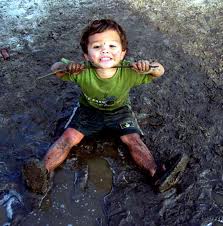 holes that need to be dug, and mudpies that need to be made. The world’s classroom teaches them that problems can be solved and obstacles can be conquered. When imaginations soar, everything becomes possible.
holes that need to be dug, and mudpies that need to be made. The world’s classroom teaches them that problems can be solved and obstacles can be conquered. When imaginations soar, everything becomes possible.
It is in the small moments of discovery that big dreams are born. When little fingers are buried in the earth, an archeologist has made his first dig. When curious eyes peer at stars through a paper-towel roll, an astronaut has made her first spacewalk. When small hands wrap a washcloth cast around a puppy’s paw, a doctor has healed his first patient.
Just as letters of the alphabet on their own have no meaning, but used in concert with each other can create poetry, literature, and song, so learning the mechanics of words and numbers alone has no purpose, but placed in the context of life being lived can create wonders as yet unseen.
‘Let the children play’ has become a clarion call in some parenting circles in recent years, and with good reason. With childhood obesity, illnesses, and depression rates all on the rise, examining the way we raise and educate our children is vital for the health of our children, our nation, and our future.
We need to find a place in our busy lives for children to be children, to enjoy the simple pleasures we enjoyed as children, to dream and imagine and create and become. Life is for living, and children are experts at living life to the fullest. We would do well to learn from them.
~~~~~~~~~~
My little funnyface enjoyed the movie version of The Lorax when we saw it last week, but then forgot all about it. But when we read the book together a few days later, it captured her imagination! She painted her face orange with face paints this morning, drew on a yellow Lorax mustache, and spent the entire day outside building a Lorax forest out of odds and ends she gathered from around the yard.
My sick baby has pneumonia and has been spiking a fever of up to 104 degrees the last few days. She’s been laminated to me, too sick to even hold up her little head, poor thing. But today when she saw a cardboard box she immediately climbed down off my lap and into the box where she played happily for a few minutes for the first time in days. Mommy’s heart was happy to see a little spark of my playful girl again, for sure. The power of a cardboard box knows no bounds!
Don’t believe in the wondrous power of play? Check out the next Steve Jobs in the making! Here’s the story of a nine year old boy, an old parts shop, and a cardboard box arcade:
Related posts:
Children who love to read…READ! Engaging children’s hearts in the wonder of reading instead of just training their minds in its mechanics. Raising Bookworms
Think homeschooled children are unsocialized, over-controlled, locked-away-from-the-world misfits? Think again! My Renaissance Girl
On a Winnie the Pooh style ‘long explore’ my little Pooh Bear discovered the world in ways only a toddler can do in…
Raising Super Readers~The MARVELous Power of Comic Books!
Playground Confessions~Look Who’s Talking!
Alphabet Fun~Imagination From A to Z!
Live to Play~Play to Learn~Learn to Live!
 Award-winnning author, L.R.Knost, is the founder and director of the children's rights advocacy and family consulting group, Little Hearts/Gentle Parenting Resources, and Editor-in-Chief of Holistic Parenting Magazine. Books by L.R.Knost include Whispers Through Time: Communication Through the Ages and Stages of Childhood ; Two Thousand Kisses a Day: Gentle Parenting Through the Ages and Stages ; The Gentle Parent: Positive, Practical, Effective Discipline ; and Jesus, the Gentle Parent: Gentle Christian Parenting the first four books in the Little Hearts Handbook gentle parenting series, and children’s picture books Petey’s Listening Ears and the soon-to-be-released Grumpykins series.
Award-winnning author, L.R.Knost, is the founder and director of the children's rights advocacy and family consulting group, Little Hearts/Gentle Parenting Resources, and Editor-in-Chief of Holistic Parenting Magazine. Books by L.R.Knost include Whispers Through Time: Communication Through the Ages and Stages of Childhood ; Two Thousand Kisses a Day: Gentle Parenting Through the Ages and Stages ; The Gentle Parent: Positive, Practical, Effective Discipline ; and Jesus, the Gentle Parent: Gentle Christian Parenting the first four books in the Little Hearts Handbook gentle parenting series, and children’s picture books Petey’s Listening Ears and the soon-to-be-released Grumpykins series.
Raising Super Readers~The MARVELous Power of Comic Books!
 Captain America made his comic book debut on this day in 1941. He embodied the American Dream, a nobody who became a somebody, an everyday, struggling, working class American who became a hero.
Captain America made his comic book debut on this day in 1941. He embodied the American Dream, a nobody who became a somebody, an everyday, struggling, working class American who became a hero.
For Captain America, the dream became a reality because of a diabolical villain trying to take over the world and a risky scientific experiment to create a hero who could stop him. (Seriously, though, who would really let strangers stick them in a radiation chamber and inject green slime into their body?!?)
For children who feel like nobodies, though, who struggle everyday, who have to work harder in class than their peers, Captain America might just be the key to unlocking the power to read.
Children like My Renaissance Girl who struggle with severe dyslexia and/or other learning disabilities as well as children who don’t have learning disabilities but are reluctant readers [ImaginationSoup.net] often rely heavily upon illustrations to help them keep track of the storyline. This provides them with the motivation to continue to read, which in turn increases their ability to read, thus increasing their motivation to read…success leading to success…a virtuous circle!
However a problem arises because, while high quality, beautifully illustrated children’s picture books abound, books appropriate for and of interest to older children often are either sparsely illustrated or not illustrated at all.
Enter the comic book!
Comic books, now generally known as graphic novels, have increasingly been finding their way into classrooms and school libraries as teachers search for tools to not only help their students learn how to read, but to tap into the vivid imagination that is the hallmark of childhood and turn their students onto a lifelong love of reading.
The Graphic Classroom founder, Chris Wilson, has made it his mission to seek out excellent graphic novels covering a wide range of subjects and styles and get them into the public education system here in the U.S.
From Da Vinci: The Renaissance Man to The Action Bible, the graphic novel industry has come a long way from the days of Archie and Jughead. The venerable Stan Lee, himself a rags to riches story on the order of his Marvel character, Captain America, is credited with a large portion of the popularity of the ever more sophisticated world of the graphic novel. His relatable characters, real-world storylines, conversational style, and stunning graphic art have contributed immeasurably to the emergence of graphic novels from the dark ages of the dime store shelves to a powerhouse industry with much to offer the literary world.
When it comes to literacy, Stan Lee brought his own superpowers into play with the formation of the Stan Lee Foundation “to do whatever I could to fight illiteracy in children. Any child who grows up illiterate, unable to read and write — or even semi-literate — can be considered handicapped. Competition throughout the world has grown so keen that every young person needs every possible advantage to even the competitive playing field. The ability to read well, to study, comprehend, and process information is absolutely vital for success as an adult.”
Utilizing graphics in teaching reading is certainly not a foreign concept. Picture books for younger children have been used for centuries to interest children in the written word. (Check out this incredibly cool Superhero ABC graphic art novel for early childhood education!) But incorporating art in the form of illustrations and graphics into curriculum for older students seems to be a relatively new and somewhat controversial concept as evidenced by the Common Core State Standards [Education Week] being adopted in all but three states so far which states “the text should be central, and surrounding materials should be included only when necessary, so as not to distract from the text itself.”
Clearly, the object of the Common Core State Standards is to focus on the mechanics of reading, in effect producing students able to read manuals and textbooks, but with no engagement of the heart, no delighting of the soul, no enrichment of the imagination. In short, the purpose seems to be to produce a generation of automatons who can pass a test on Da Vinci, but can’t think or create or imagine or invent like Da Vinci.
When you consider that “Reading correlates with almost every measurement of positive personal and social behavior surveyed, from scholarship and job success to voting and playing sports.” [BookReporter.com], it makes more sense to raise bookworms than to program robots.
Successful reading means far more than possessing the ability to read. Engaging the hearts of students moves reading success beyond a life skill and turns it into a life style. Children who love to read…READ. Adults who love to read…READ. And graphic novels are too powerful of a tool in our arsenal to be disregarded because of pride or prejudice.
~Excelsior
Related posts:
Children who love to read…READ! Engaging children’s hearts in the wonder of reading instead of just training their minds in its mechanics. Raising Bookworms
8 Reasons to Let Your Kids Read Comics. Imagination Soup
It’s time for a return to childhood, to simplicity, to running and climbing and laughing in the sunshine, to experiencing happiness instead of being trained for a lifetime of pursuing happiness…it’s time to let children be children again. A Return to Childhood
Think homeschooled children are unsocialized, over-controlled, locked-away-from-the-world misfits? Think again! My Renaissance Girl
Playground Confessions~Look Who’s Talking!
Alphabet Fun~Imagination From A to Z!
Live to Play~Play to Learn~Learn to Live!
 Award-winnning author, L.R.Knost, is the founder and director of the children's rights advocacy and family consulting group, Little Hearts/Gentle Parenting Resources, and Editor-in-Chief of Holistic Parenting Magazine. Books by L.R.Knost include Whispers Through Time: Communication Through the Ages and Stages of Childhood ; Two Thousand Kisses a Day: Gentle Parenting Through the Ages and Stages ; The Gentle Parent: Positive, Practical, Effective Discipline ; and Jesus, the Gentle Parent: Gentle Christian Parenting the first four books in the Little Hearts Handbook gentle parenting series, and children’s picture books Petey’s Listening Ears and the soon-to-be-released Grumpykins series.
Award-winnning author, L.R.Knost, is the founder and director of the children's rights advocacy and family consulting group, Little Hearts/Gentle Parenting Resources, and Editor-in-Chief of Holistic Parenting Magazine. Books by L.R.Knost include Whispers Through Time: Communication Through the Ages and Stages of Childhood ; Two Thousand Kisses a Day: Gentle Parenting Through the Ages and Stages ; The Gentle Parent: Positive, Practical, Effective Discipline ; and Jesus, the Gentle Parent: Gentle Christian Parenting the first four books in the Little Hearts Handbook gentle parenting series, and children’s picture books Petey’s Listening Ears and the soon-to-be-released Grumpykins series.
Seuss-ified~Craft-astic~Snack-errific~Education-cool~Fun!
“You’re never too old, too wacky, too wild, to pick up a book and read to a child!”
Seussville~Read Across America
March 1st is World Book Day, and March 2nd is Dr. Seuss’ Birthday Extravaganza which includes the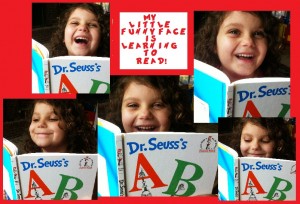 release of the much-anticipated new movie, The Lorax! If you’re a book-obsessed, homeschooling, movie-loving, Seussiac like I am, it’s practically a national holiday! And when you add my excitement over my newest little home-grown reader, it’s definitely time for a Seusserrific Celebration!
release of the much-anticipated new movie, The Lorax! If you’re a book-obsessed, homeschooling, movie-loving, Seussiac like I am, it’s practically a national holiday! And when you add my excitement over my newest little home-grown reader, it’s definitely time for a Seusserrific Celebration!
In honor of all of this wonderfulness and to help launch my new little reader into the wonderful world of books, I’ve been scouring the web, the bookshelves, and my scattered brain for all the Seussical fun I could find for my little people and yours. Here are a few of my finds!
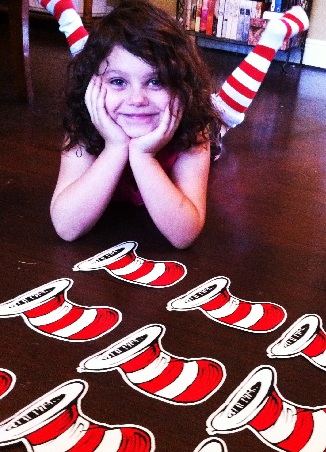 Staples has these awesome Cat in the Hat cutouts intended for use on a bulletin board, but we repurposed them for several games such as BIG LETTER~little letter Match-up and Seusstastic Scavenger Hunt. For BIG LETTER~little letter Match-up I drew capital letters and their counterparts on the backs of the cutouts and laid them out in a 3 x 3 grid. For Seusstastic Scavenger Hunt I wrote clues on the cutouts to help my little people find Dr. Seuss books I’d hidden throughout the house and tucked the clues in each book so that when they found one book and we read it, they’d find the next clue hidden in the pages of the book they’d just found…a two-fer! So fun!
Staples has these awesome Cat in the Hat cutouts intended for use on a bulletin board, but we repurposed them for several games such as BIG LETTER~little letter Match-up and Seusstastic Scavenger Hunt. For BIG LETTER~little letter Match-up I drew capital letters and their counterparts on the backs of the cutouts and laid them out in a 3 x 3 grid. For Seusstastic Scavenger Hunt I wrote clues on the cutouts to help my little people find Dr. Seuss books I’d hidden throughout the house and tucked the clues in each book so that when they found one book and we read it, they’d find the next clue hidden in the pages of the book they’d just found…a two-fer! So fun!
We also made up a Go Fish in the Bowl game matching upper and lower case letters. It’s just your basic Go Fish, but somehow on Cat in the Hat cut-outs it became magical!
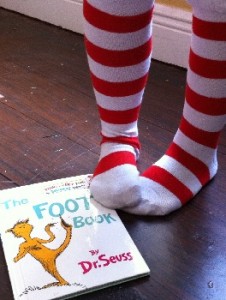 The simple addition of some stripey ‘Seuss Socks’ (Dollar Tree!) was enough to make The Foot Book even more engaging than it already is on its own!
The simple addition of some stripey ‘Seuss Socks’ (Dollar Tree!) was enough to make The Foot Book even more engaging than it already is on its own!
Some leftover pieces of an old game yielded a plastic Green Eggs and Ham to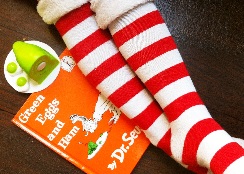 play a Would You~Could You spin on the old Mother May I game. We placed the Green Eggs and Ham game piece at one end of the room and took turns asking questions like ‘Would you, could you let me take three steps forward?’ and giving directions like ‘Could you, would you jump up and down and take one step back?’
play a Would You~Could You spin on the old Mother May I game. We placed the Green Eggs and Ham game piece at one end of the room and took turns asking questions like ‘Would you, could you let me take three steps forward?’ and giving directions like ‘Could you, would you jump up and down and take one step back?’
We’re putting together a Seuss Quiet Bag which we’ll be adding to over time, and I’m working on making a Cat in the Hat Calm-Me-Jar for our bag. I’ll post a picture here as soon as it’s done! Right now we’ve got favorite books and our Go Fish in the Bowl cards in this cute, little Seuss backpack I found at a thrift store.
Here it is! Meet the The Cat in the Hat Can Help You with That Calm-Me-Jar!
And here is my six year old’s contribution to the Seuss Birthday celebration~Seuss Tower! Watch out Donald, my little funny-face is out to trump you, lol!
Check out these 7 Tips for Raising Bookworms!
Here are some awesomely Seusstastic links to crafts and games and yummy Seuss treats you and your little ones will love!
Source: zakkalife.blogspot.com via Linda on Pinterest
Make Seusstastic Lorax trees from pencils!
Source: meetthedubiens.com via Linda on Pinterest
Oreos, white and red chocolate, and marshmallows equal Seussalicious Cat in the Hat cookies!
Source: madtownmacs.blogspot.com via Linda on Pinterest
A Seussville craft for little Seusslets to create!
And check out this abSeusslutely ObSeussed site for literally hundreds and hundreds of Seusstastic crafts, books, games, recipies, ideas, and links!
Related posts:
Children who love to read…READ! Engaging children’s hearts in the wonder of reading instead of just training their minds in its mechanics. Raising Bookworms
It’s time for a return to childhood, to simplicity, to running and climbing and laughing in the sunshine, to experiencing happiness instead of being trained for a lifetime of pursuing happiness…it’s time to let children be children again. A Return to Childhood
Think homeschooled children are unsocialized, over-controlled, locked-away-from-the-world misfits? Think again! My Renaissance Girl
A Seussical List of Parenting Tips!
Alphabet Fun~Imagination From A to Z!
Live to Play~Play to Learn~Learn to Live!
Making Money Matters Make Cents
One Slippery Sock & Other Silly Tools for your Parenting Toolbox!
 Award-winnning author, L.R.Knost, is the founder and director of the children's rights advocacy and family consulting group, Little Hearts/Gentle Parenting Resources, and Editor-in-Chief of Holistic Parenting Magazine. Books by L.R.Knost include Whispers Through Time: Communication Through the Ages and Stages of Childhood ; Two Thousand Kisses a Day: Gentle Parenting Through the Ages and Stages ; The Gentle Parent: Positive, Practical, Effective Discipline ; and Jesus, the Gentle Parent: Gentle Christian Parenting the first four books in the Little Hearts Handbook gentle parenting series, and children’s picture books Petey’s Listening Ears and the soon-to-be-released Grumpykins series.
Award-winnning author, L.R.Knost, is the founder and director of the children's rights advocacy and family consulting group, Little Hearts/Gentle Parenting Resources, and Editor-in-Chief of Holistic Parenting Magazine. Books by L.R.Knost include Whispers Through Time: Communication Through the Ages and Stages of Childhood ; Two Thousand Kisses a Day: Gentle Parenting Through the Ages and Stages ; The Gentle Parent: Positive, Practical, Effective Discipline ; and Jesus, the Gentle Parent: Gentle Christian Parenting the first four books in the Little Hearts Handbook gentle parenting series, and children’s picture books Petey’s Listening Ears and the soon-to-be-released Grumpykins series.
One Slippery Sock & Other Silly Tools for your Parenting Toolbox
They say laughter is the best medicine. While that may be true, there are other important uses for the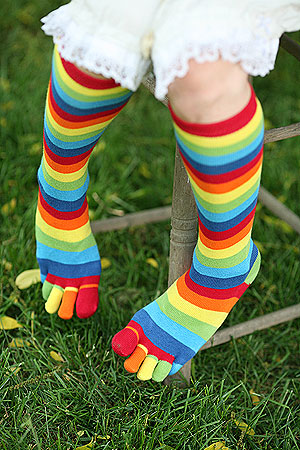 tincture of silliness that should not be overlooked! Here are a few:
tincture of silliness that should not be overlooked! Here are a few:
- Your two-year-old digs his heels in at bedtime in an Oscar-worthy imitation of a mule. Give the ‘one slippery sock’ routine a try. Put socks on your feet and, when you call him to head off with you to begin your bedtime routine, start slipping and sliding on one side. Just little slips and slides will do the trick, along with a good helping of parental confusion over the possible reasons you’re having so much trouble walking. Little people love slap-stick, and you can bet your dawdler will hurry along to get in on the fun!
- Your eighteen-month-old suddenly stops enjoying the novelty of tooth-brushing and locks her little jaws tighter than a bulldog latched onto a bone. Try ‘tickling the ivories.’ Brush your own teeth first, giggling and dancing around the bathroom the whole time like you’re tickled at being tickled (while your little one watches, of course). Then release the gentle tooth-tickler on your most likely already giggling baby and say, “Tickle teeth! Tickle teeth!” while brushing those pearly whites.
- Your three-year-old eschews the use of shoes no matter how many choices of style and color you offer. Try the ‘superhero’ approach. Instead of the tired, old, “Time to get your shoes on,” routine…say, “The terrible-toe-tickling super villain is on the loose! We need some superhero armor on those feet, quick!” Be prepared to take the time to discuss the relative protective qualities of the available ‘armor’, but then get those toes to safety!
- Your six-year-old chatterbox could make a monk revoke his vow of silence just to say “Shhhhhh!!!” Try the ‘seven super silly seals sent slippery slippers to their sisters’ treatment. Give your little chatterbox a tongue-tying-twisty-treat and the promise of your full attention for five minutes when she thinks she’s ready to say it ten times fast. Then enjoy your two minutes of quiet until she returns!
- Your nine- and seven-year-olds are at each other like cats with their tails tied together. How about a ‘bag on your head while you listen to the ‘he said/she said’? When you head in to break up the gazillionth argument of the day, slip a paper bag with a great big goofy smile and a couple of googly eyes drawn on it over your head first. It may not solve everything, but it’ll be super hard for them to stay mad at each other, and a little levity might just diffuse the tension!
- Your high-schooler is one stressed-out teen with SATs looming, homework mounting, friend drama annoying, and hormones swirling. It’s time for a ‘pajama-night-out-orama’! Wait until the house settles, everyone’s in bed for the night, and all is quiet…then leave your spouse in charge of the house while you sneak your teen out the back door with you for a one-on-one run through Dunkin’ Donuts and sit in the car in your driveway stuffing your faces and letting her unstuff all the angst that’s been building up inside of her. Might not be good for your arteries, but it’ll do her heart a world of good!
Silly works! Don’t handicap your parenting by forgetting one of the most powerful tools in your parenting toolbox.
Related posts:
Babes and Boundaries~A Gentle Parenting Perspective
Parenting in Public: Toddler Time
 Award-winnning author, L.R.Knost, is the founder and director of the children's rights advocacy and family consulting group, Little Hearts/Gentle Parenting Resources, and Editor-in-Chief of Holistic Parenting Magazine. Books by L.R.Knost include Whispers Through Time: Communication Through the Ages and Stages of Childhood ; Two Thousand Kisses a Day: Gentle Parenting Through the Ages and Stages ; The Gentle Parent: Positive, Practical, Effective Discipline ; and Jesus, the Gentle Parent: Gentle Christian Parenting the first four books in the Little Hearts Handbook gentle parenting series, and children’s picture books Petey’s Listening Ears and the soon-to-be-released Grumpykins series.
Award-winnning author, L.R.Knost, is the founder and director of the children's rights advocacy and family consulting group, Little Hearts/Gentle Parenting Resources, and Editor-in-Chief of Holistic Parenting Magazine. Books by L.R.Knost include Whispers Through Time: Communication Through the Ages and Stages of Childhood ; Two Thousand Kisses a Day: Gentle Parenting Through the Ages and Stages ; The Gentle Parent: Positive, Practical, Effective Discipline ; and Jesus, the Gentle Parent: Gentle Christian Parenting the first four books in the Little Hearts Handbook gentle parenting series, and children’s picture books Petey’s Listening Ears and the soon-to-be-released Grumpykins series.
Babes and Boundaries~A Gentle Parenting Perspective
[Reprinted from Two Thousand Kisses a Day: Gentle Parenting Through the Ages and Stages by L.R.Knost. Whispers Through Time: Communication Through the Ages and Stages of Childhood also now available on Amazon]
 Parenting is soooo tiring and frustrating at times. Sometimes you just want to sit a small child down and say, “Do you know how much easier your life (and mine!) would be if you’d just be REASONABLE?!?” But we know that wouldn’t do any good because the words ‘reasonable’ and ‘toddler/preschooler’ just don’t play well together. The thing to remember is that gentle parenting doesn’t mean parenting without boundaries.
Parenting is soooo tiring and frustrating at times. Sometimes you just want to sit a small child down and say, “Do you know how much easier your life (and mine!) would be if you’d just be REASONABLE?!?” But we know that wouldn’t do any good because the words ‘reasonable’ and ‘toddler/preschooler’ just don’t play well together. The thing to remember is that gentle parenting doesn’t mean parenting without boundaries.
Believe it or not, the foundation for discipline (guiding, leading, teaching…NOT punishment ) begins in the newborn and infancy stages. When parents respond quickly, consistently, and gently to their baby’s cries, the trust relationship that the parent is establishing becomes the cornerstone for later discipline. Boundaries need to be established for a child’s safety and growth into a successful citizen of our world. A child who is secure in the knowledge that he doesn’t have to fight to be heard or to have his needs met is more open and adaptable to limits. And when the ‘limit-setter’ is a person the child trusts, the enforcement of those boundaries becomes a matter of connection and communication instead of conflict and struggle.
So, what might setting and enforcing boundaries using gentle parenting look like in real life? Here are a few examples:
- Your 18 month old has begun hitting you whenever you try the ‘remove and distract’ method of keeping her from sticking things into power outlets. In addition to covering the outlets with safety covers, a gentle parenting approach to hitting at this age would be to gently hold your child’s hand when she tries to hit, look her in the eye, and say quietly and firmly, “Gentle” or “Gentle hands,” while stroking your cheek with her hand. This sets a boundary that hitting is not okay while demonstrating what behavior is acceptable. Don’t expect this to be a one-time deal, though. Little ones learn through consistent and patient repetition.
- Your 2 year old drops to the ground in limp protest every time you try to leave ANYWHERE! First, giving a toddler some warning that a change is about to occur respects their often intense interest in and focus on their own activities. A gentle parenting approach might be to utilize the ‘countdown to leaving’ method to give them a time context (i.e. “Five more minutes! That means you have enough time for five more horsey rides on grandpa’s back!”… “Four more minutes! That means you can have four more jumps into the ballpit!”… “Three more minutes! That means you have enough time to build three more towers and knock them down!”… “Two minutes left! That means you have enough time to go down the slide two more times!”… “One more minute! That means you can look at one more book!”). Remember, children aren’t little robots we can just upload the right program into and expect it to work perfectly every time, so when your little human still impersonates a limp noodle despite your best efforts, quietly acknowledge his distress, “It’s hard to leave when you’re having fun, isn’t it?” and then gently pick him up and move him to the car/stroller, etc.
- Your 3 year old flat out refuses to wear shoes, period. In addition to giving choices, “Do you want to wear the red boots or the blue sneakers today?” and offering her the opportunity to assert her independence, “Would you like to put your shoes on yourself or do you want mommy to help?” sometimes all that is needed is a simple question, “Why don’t you want to wear shoes?” Three year olds are typically becoming articulate enough that, if they aren’t already stressed, they can do a pretty good job of explaining themselves. You might be surprised to hear something like, “Tomowow my boos hut my toes,” which when translated means, “The last time I wore my boots they hurt my feet, and now I think all shoes will hurt me.” Moving on to a more verbal communication stage of your relationship with your child when they’re ready might seem a no-brainer, but parents often get caught up in patterns of parenting from previous stages and it just doesn’t occur to them to simply ask their child what’s wrong. Again, this won’t always work, so when your little bohemian still rejects all things soled, calmly let her know that she will remain in the stroller/sling/cart and not do any walking until she decides she’s ready to put on her shoes.
One other note about parental boundaries is that it’s not just your children who will challenge them! Everyone and their mother (or especially their mother!) will take every ‘misbehavior’ by your child as an opportunity to give you unsolicited and often unwanted advice. Remember, when it comes down to it, it’s you, the parent, who determines what limits to set. Mrs. In-My-Day, Cousin Know-It-All, Mr. My-Way-Is-The-Only-Way, and Neighbor Nose-In-Everyone-Else’s-Business all have their own ideas that make sense to them, and that’s fine, but you are not them! You the unique parent of a unique individual, and you have the sole responsibility to raise that individual as you see fit (with reasonable limits set by your community as to what constitutes abuse, neglect, etc).
Everyone and their mother (or especially their mother!) will take every ‘misbehavior’ by your child as an opportunity to give you unsolicited and often unwanted advice. Remember, when it comes down to it, it’s you, the parent, who determines what limits to set. Mrs. In-My-Day, Cousin Know-It-All, Mr. My-Way-Is-The-Only-Way, and Neighbor Nose-In-Everyone-Else’s-Business all have their own ideas that make sense to them, and that’s fine, but you are not them! You the unique parent of a unique individual, and you have the sole responsibility to raise that individual as you see fit (with reasonable limits set by your community as to what constitutes abuse, neglect, etc).
In practical application, boundaries do reflect the culture and environment in which a child lives. In a small, rural community in Spain, doors may be left open day and night and the neighbors may all be related. Small children might have the freedom to wander in and out of houses, play ball in the middle of the road, and plop down for an afternoon nap on a neighbor’s sofa. In a busy, urban city such as New York, doors may be kept locked, people may never have even met their neighbors, and playing in the street might be tantamount to a child endangerment charge.
The point is that boundaries aren’t a one-size-fits-all list that you can buy from Barnes & Noble, put on the fridge, and slap a sticker on every time a child complies. Boundaries are personal limits determined by the parent’s values and priorities and culture as well as reflecting the age and maturity of their child and the unique attributes of their community.
It may ‘take a village’ to raise a child, but remember, it’s you, the parent, who’s the leader of your tribe!
Related posts:
Testing the Boundaries~What’s A Parent To Do?
Toddlers, Tantrums, and Time-Ins, Oh My!
The Taming of the Tantrum: A Toddler’s Perspective
 Award-winnning author, L.R.Knost, is the founder and director of the children's rights advocacy and family consulting group, Little Hearts/Gentle Parenting Resources, and Editor-in-Chief of Holistic Parenting Magazine. Books by L.R.Knost include Whispers Through Time: Communication Through the Ages and Stages of Childhood ; Two Thousand Kisses a Day: Gentle Parenting Through the Ages and Stages ; The Gentle Parent: Positive, Practical, Effective Discipline ; and Jesus, the Gentle Parent: Gentle Christian Parenting the first four books in the Little Hearts Handbook gentle parenting series, and children’s picture books Petey’s Listening Ears and the soon-to-be-released Grumpykins series.
Award-winnning author, L.R.Knost, is the founder and director of the children's rights advocacy and family consulting group, Little Hearts/Gentle Parenting Resources, and Editor-in-Chief of Holistic Parenting Magazine. Books by L.R.Knost include Whispers Through Time: Communication Through the Ages and Stages of Childhood ; Two Thousand Kisses a Day: Gentle Parenting Through the Ages and Stages ; The Gentle Parent: Positive, Practical, Effective Discipline ; and Jesus, the Gentle Parent: Gentle Christian Parenting the first four books in the Little Hearts Handbook gentle parenting series, and children’s picture books Petey’s Listening Ears and the soon-to-be-released Grumpykins series.
Alphabet Fun~Imagination from A to Z!
Logic will get you from A to B. Imagination will take you everywhere.
~Albert Einstein
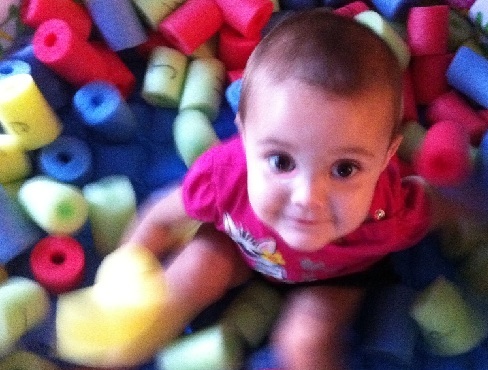 Imagination is the language of childhood, so speaking their language when introducing our language only makes sense. Let’s ditch the flashcards, turn off the educational dvd’s, and throw out the worksheets because learning is child’s play!
Imagination is the language of childhood, so speaking their language when introducing our language only makes sense. Let’s ditch the flashcards, turn off the educational dvd’s, and throw out the worksheets because learning is child’s play!
In Fun with Funoodles we cut up a bunch of foam pool noodles and wrote letters on them for all sorts of funoodley fun!
Alphabet Fishing is a fun game that can be used to introduce letters, match upper and lower cases, work on beginning sounds, build words, and more!
Fill a bathtub or a bucket with a few inches of water (Supervise, supervise, supervise! Never leave a young child alone with even an inch of standing water, not even for a minute!), tie a string to a small plastic rod, and attach a piece of metal to the other end of the string, and then you can play games like:

Catch the Letters
For letter introduction, choose the letters in your child’s name or 3 to 5 random letters and toss them in the tub, then let them ‘catch’ whatever their pole lands on and name it for them. An alternative is to name a letter for them to catch and play ‘hot-n-cold’ until they get it, or show them a letter on a card and have them catch the matching letter.
Catch and Match
For upper and lowercase matching, put a few capital or lowercase letters in the tub and line up their matches beside the tub and let them ‘catch and match’ them. (We call the uppercase letters the ‘Mommy’ letters and the lowercase letters the ‘Baby’ letters, and when the Baby letters fall in the water, my little ones love to come to the rescue and reunite them with their Mommy letters!)
Sounders
Find pictures of things with the first letters you are working on (like a picture of a dog for D and a cat for C, etc) and either cut them out yourself or let your little one do it if they like to cut (it doesn’t have to be perfect and it’s great practice!), then put the letters under the picture except for the first letters (or vowels if they’re beyond beginning sounds) and toss the missing letters in the tub. Help your child make the sound that completes the word and identify which letter makes that sound, them let them catch it and put it in place.
 For sunshiny days, head outside with some sidewalk chalk and a few other odds-n-ends because a ton of learning fun can be had in the sun!
For sunshiny days, head outside with some sidewalk chalk and a few other odds-n-ends because a ton of learning fun can be had in the sun!
Alpha-Toss
Write out a few of the letters you’re working on or just the letters in your little one’s name. Get a small rock or beanbag and let your child have fun throwing it onto the letters you call out or get a toy truck and let your child try to roll it just hard enough to get it to come to a stop on the right letter.
 Alphabet Hop-Scotch
Alphabet Hop-Scotch
Have your little one hop, skip, and jump their way through a maze of alphabet letters drawn in sidewalk chalk, calling out each letter as they land on it. Or write the letters you’re working on mixed in with other letters or just random shapes and have them jump over and around the wrong boxes to get to the right ones.
Wordfind
Draw a big wordfind box on the sidewalk with words ‘hidden in plain sight’ (i.e. all of the words hidden horizontally). For earlier learners use no more than a four letter by four letter box, and for slightly older learners use a six by six letter box. Write the words they’re looking for right beneath the box for easy reference.
Wooden blocks with just one letter on them are ideal, but magnetic or foam letters will work, too. Take the letters of your child’s name or another small group of letters and hide them in your yard (or inside your house if the weather is bad). Play ‘hot-n-cold’ to help your child find the letters and have them call out the letter names as they find them.
Build-A-Word
Write a word on the sidewalk and hide the letters to the word around the yard. As your child finds each letter, they run back and put the letter on top of the chalk letter until they’ve built the word.
I-Spy-Alphabet
Hide letters around the yard and give your child clues in I-Spy form (i.e. “I spy with my little eye a letter hidden under something blue!”)
Circle of Words
Use sidewalk chalk to write action words like ‘spin’ and ‘sing’ and ‘clap’ in a big circle, then either read them to your child or help them sound them out, depending on their reading level. Grab a camera and click away as they spin and sing and clap their way to reading! 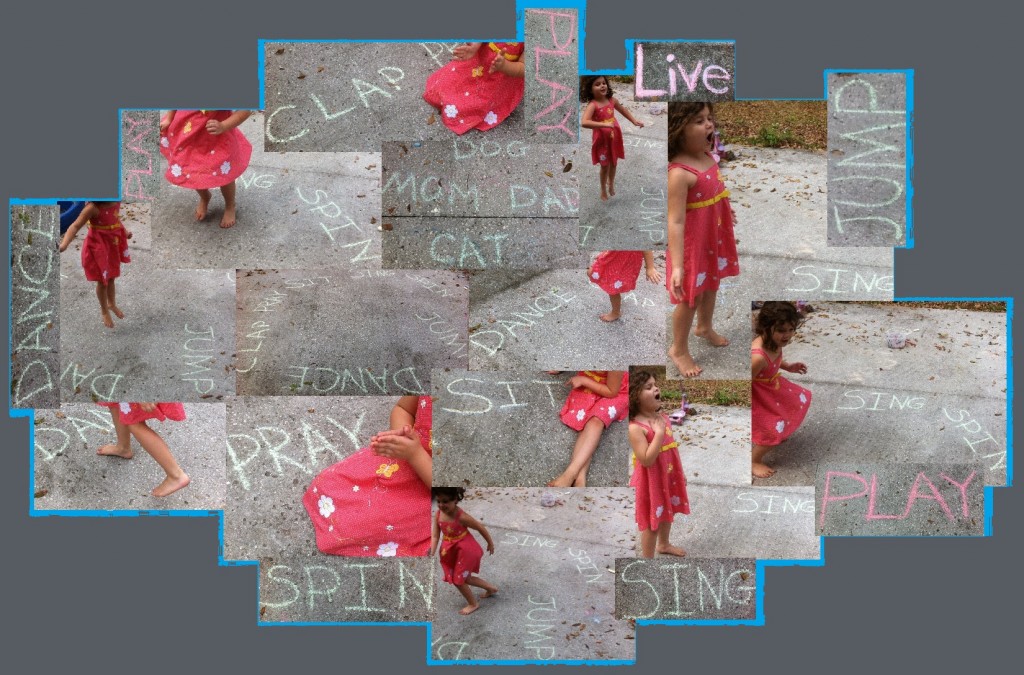
For days when going outdoors just isn’t an option, here are a few ideas to keep the learning fun and fresh:
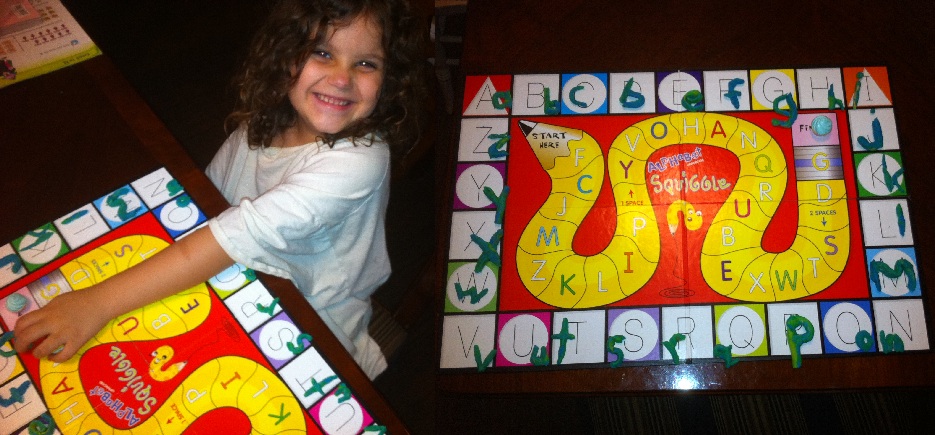 ABC Playdoh Matching
ABC Playdoh Matching
I found an old board game with no game pieces at a yard sale for 10 cents. It had the letters of the alphabet in all capitals, though, so I knew it would make a good DIY game of some sort. We used it as a fun review of the ‘mommy’ letters and the ‘baby’ letters by grabbing some playdoh and making it a matching game! The tactile use of playdoh to make the baby letters is a wonderful reinforcement of their shape, helping little learners to remember them far better than simply looking at them or writing them.
And when your little learner is ready to read, here are some word family activities that they may enjoy:
Fashion Friends Word Family
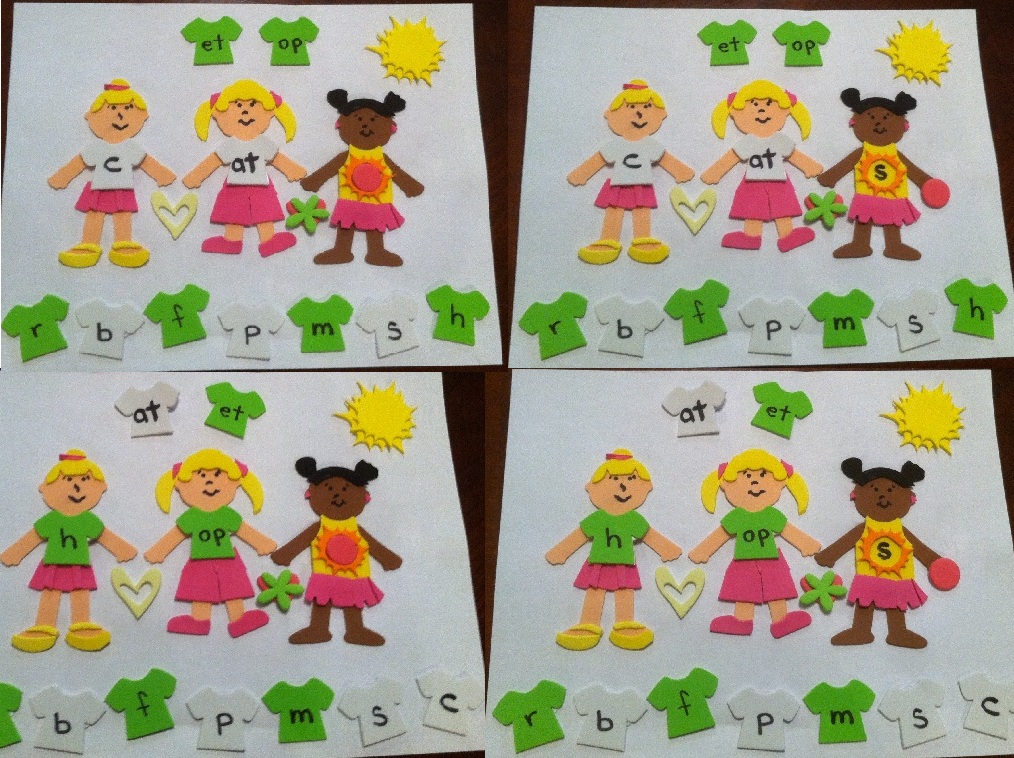 These little bff’s are mini fashionistas who love to coordinate their clothes so they make a statement everywhere they go! Little Miss Middle chooses which word family shirt to wear, then Little Miss Left chooses a shirt with a letter that makes a word, and, when there are more than one of anything, Little Miss Right reveals her ‘S’uperpower…she gets ‘S’o ‘S’uper excited she becomes ‘S’upergirl and makes the word plural with her ‘S’uper ‘S’! (These are just foam sticker people from Michael’s I cut up and made into the Fashion Friends. Check back next week for the Superhero Friends C, S, T, W, P, and H as they conquer the alphabet universe and use their superpowers to create new sounds that are out of this world!)
These little bff’s are mini fashionistas who love to coordinate their clothes so they make a statement everywhere they go! Little Miss Middle chooses which word family shirt to wear, then Little Miss Left chooses a shirt with a letter that makes a word, and, when there are more than one of anything, Little Miss Right reveals her ‘S’uperpower…she gets ‘S’o ‘S’uper excited she becomes ‘S’upergirl and makes the word plural with her ‘S’uper ‘S’! (These are just foam sticker people from Michael’s I cut up and made into the Fashion Friends. Check back next week for the Superhero Friends C, S, T, W, P, and H as they conquer the alphabet universe and use their superpowers to create new sounds that are out of this world!)
Note: As long as your child is having fun, meaningful learning is taking place. But when frustration begins to surface (whining, refusing to cooperate, complaining, etc.) take that as your cue to take a break or make some silly new game rules or let your child take the lead and make up some new games. You never know what you might learn!
Related posts:
25 Must-Have Books for Baby Bookworms
25 Must-Have Books for Toddler Bookworms
Making Money Matters Make Cents
 Award-winnning author, L.R.Knost, is the founder and director of the children's rights advocacy and family consulting group, Little Hearts/Gentle Parenting Resources, and Editor-in-Chief of Holistic Parenting Magazine. Books by L.R.Knost include Whispers Through Time: Communication Through the Ages and Stages of Childhood ; Two Thousand Kisses a Day: Gentle Parenting Through the Ages and Stages ; The Gentle Parent: Positive, Practical, Effective Discipline ; and Jesus, the Gentle Parent: Gentle Christian Parenting the first four books in the Little Hearts Handbook gentle parenting series, and children’s picture books Petey’s Listening Ears and the soon-to-be-released Grumpykins series.
Award-winnning author, L.R.Knost, is the founder and director of the children's rights advocacy and family consulting group, Little Hearts/Gentle Parenting Resources, and Editor-in-Chief of Holistic Parenting Magazine. Books by L.R.Knost include Whispers Through Time: Communication Through the Ages and Stages of Childhood ; Two Thousand Kisses a Day: Gentle Parenting Through the Ages and Stages ; The Gentle Parent: Positive, Practical, Effective Discipline ; and Jesus, the Gentle Parent: Gentle Christian Parenting the first four books in the Little Hearts Handbook gentle parenting series, and children’s picture books Petey’s Listening Ears and the soon-to-be-released Grumpykins series.
If You Give A Toddler A Book…
[By L.R.Knost, author of Two Thousand Kisses a Day: Gentle Parenting Through the Ages and Stages, Whispers Through Time: Communication Through the Ages and Stages of Childhood, and The Gentle Parent: Positive, Practical, Effective Discipline available on Amazon and through other major retailers.]
~~~~~~~~~~~~~~~~~~~~~
He’ll climb into your lap
While he’s in your lap
He might lay his head on your chest
When he lays his head on your chest
He’ll hear your heartbeat
When he hears your heartbeat
He’ll probably ask if you can hear his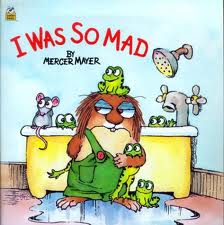
When you lean down to listen
He might kiss your nose
When he kisses your nose
You could tickle his tummy
When you tickle his tummy
He might giggle and wiggle
When he giggles and wiggles
When you hug him tight
He’ll smile like the sun
When he smiles like the sun
You’ll smile right back
When you smile right back
He might tell you he loves you
When he tells you he loves you
You’ll whisper it back
He’ll probably snuggle close
When he snuggles close
He might ask you to read to him
When he asks you to read to him
You’ll read him the book
When you read him the book
He might just learn to love…
To learn!
~L.R.Knost
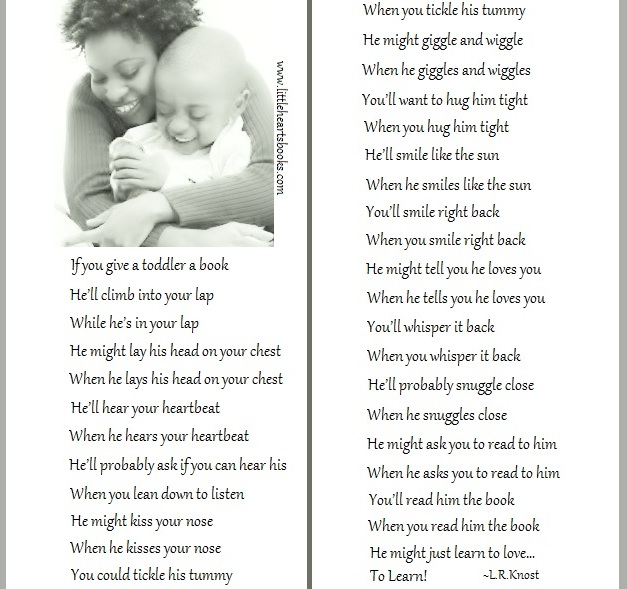 Related posts:
Related posts:
25 Must-Have Books for Baby Bookworms
25 Must-Have Books for Toddler Bookworms
Alphabet Fun~Imagination From A to Z!
Live to Play~Play to Learn~Learn to Live!
Making Money Matters Make Cents
Playground Confessions~Look Who’s Talking!
One Slippery Sock & Other Silly Tools for your Parenting Toolbox!
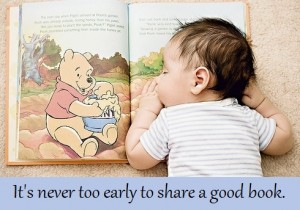
 Award-winnning author, L.R.Knost, is the founder and director of the children's rights advocacy and family consulting group, Little Hearts/Gentle Parenting Resources, and Editor-in-Chief of Holistic Parenting Magazine. Books by L.R.Knost include Whispers Through Time: Communication Through the Ages and Stages of Childhood ; Two Thousand Kisses a Day: Gentle Parenting Through the Ages and Stages ; The Gentle Parent: Positive, Practical, Effective Discipline ; and Jesus, the Gentle Parent: Gentle Christian Parenting the first four books in the Little Hearts Handbook gentle parenting series, and children’s picture books Petey’s Listening Ears and the soon-to-be-released Grumpykins series.
Award-winnning author, L.R.Knost, is the founder and director of the children's rights advocacy and family consulting group, Little Hearts/Gentle Parenting Resources, and Editor-in-Chief of Holistic Parenting Magazine. Books by L.R.Knost include Whispers Through Time: Communication Through the Ages and Stages of Childhood ; Two Thousand Kisses a Day: Gentle Parenting Through the Ages and Stages ; The Gentle Parent: Positive, Practical, Effective Discipline ; and Jesus, the Gentle Parent: Gentle Christian Parenting the first four books in the Little Hearts Handbook gentle parenting series, and children’s picture books Petey’s Listening Ears and the soon-to-be-released Grumpykins series.
Testing the Boundaries~What’s A Parent To Do?
 [Portions reprinted from The Gentle Parent: Positive, Practical, Effective Discipline by L.R.Knost. Two Thousand Kisses a Day: Gentle Parenting Through the Ages and Stages and Whispers Through Time: Communication Through the Ages and Stages of Childhood now available on Amazon and through other major retailers.]
[Portions reprinted from The Gentle Parent: Positive, Practical, Effective Discipline by L.R.Knost. Two Thousand Kisses a Day: Gentle Parenting Through the Ages and Stages and Whispers Through Time: Communication Through the Ages and Stages of Childhood now available on Amazon and through other major retailers.]
Challenging behavior in our children can be really…well, challenging! How do you ‘handle’ a child who suddenly refuses to wear shoes or sit in her carseat/seatbelt or eat, period? Here are some tips to help you regain that snuggly, loving relationship you used to enjoy before your baby became a…gulp…PERSON!
1.) Remove the word ‘handle’ from your parenting vocabulary entirely. Your child isn’t a lion to be tamed or a dog to be trained! He’s a person, an individual with thoughts, interests, concerns, wants, and needs that are totally separate from yours. Respecting him as a separate individual not only models the value we need to place on others in our homes and communities, but also sets the stage for a mutually respectful relationship in his teen years and beyond.
2.) Slow down! Often simplifying our lives is the key to simplifying our parenting issues. Rushing a child from one activity to the next doesn’t expand her horizons; it stunts her creativity and inherent zest for life, which are the building blocks of a life-long love of learning. When she digs her heels in, pay attention! She’s trying to communicate a very deep need for time and space to learn about the world, to play and grow, and to just ‘be.’
3.) Small children have very little control over their lives, and the more powerless they feel, the more likely they are to make eating, getting dressed, going to the potty, etc. a battle of wills. Giving choices, engaging your child in making plans, and being flexible and responsive on a daily basis are good ‘proactive’ parenting, but little people are notorious for their awkward timing in deciding to suddenly assert their independence! Be prepared for those challenging moments by deciding ahead of time how you will respond. (See below for some ideas!)
4.) Listen, listen, listen! The first question parents ask me is almost always, “How do I get my child to listen?” And my first response is usually, “How well do you listen?” As Ralph Waldo Emerson so aptly put it, “What you do speaks so loud that I cannot hear what you say.” In other words, our children learn best by imitation. If every time our little ones ask for our attention we say, “Just a minute,” then we cannot expect instant attention from them. If when they speak to us our eyes constantly stray back to our computers and iPhones, we should not be surprised if they have a hard time looking at us when we ask them to. Listening is a two-way street that starts and ends with us, the adults.
5.) Boundaries are our friends! Many people believe that Gentle Parenting is a form of un-parenting, but nothing could be further from the truth. Gentle Parenting is involved parenting~interactive, engaged, active parenting. It takes focused attention, planning, participation, research, and so much more to be an empathetic, responsive parent who is in tune with their child’s needs and who is prepared to make whatever sacrifices are necessary to meet those needs. That said, in any home, like in any civilized society, boundaries are necessary for everyone’s safety and comfort. It is in the choosing and maintaining of those boundaries that Gentle Parenting distinguishes itself. In a gently parented home, boundaries are focused on guiding rather than controlling children and are maintained through empathetic and creative resolutions rather than harsh punitive consequences. (See below for some ideas!)
6.) Watch your attitude! Do you have angry eyes? A sharp tone? Do you issue commands and demand compliance? Do you sigh and roll your eyes when frustrated with your little one? All of these things contribute to creating resistance in children. Really, who wants to cooperate with someone who is demanding, impatient, sarcastic, angry, etc? Does feeling like a burden or a failure ever motivate anyone? Is a desire to please rooted in correction or connection? Think about how you like to be treated by authority figures (supervisors, law enforcement, etc.) and then treat your children the way you want to be treated! This not only reduces challenging behavior, but also models The Golden Rule~Do to others as you want them to do to you…an excellent life lesson!
Here are some ideas for your Gentle Parenting toolbox:
- Little one refusing to put on shoes before leaving the house? First, ask him why he doesn’t want to wear them. A toddler most likely won’t be able to/want to explain, but you’re modeling courtesy and opening up a dialogue, both good connection points. A three-year-old, though, might just surprise you with a very logical, in their own mind at least, response! Second, don’t react; just scoop the shoes up, and take them with you. If the refusal to wear shoes continues at the park/in the library/at the doctor’s office, etc. calmly tell him he can sit in your lap or in the stroller and hang out with you until he’s ready to wear his shoes.
- If a tantrum results, remember to stay calm (deep breathing, counting silently, and saying a quick prayer for guidance are all helpful!) and remain present. Some children respond well to a parent quietly talking, offering words to express what the child may be experiencing (i.e. “It’s frustrating when we have to do things we don’t like. I can see that you’re angry, and that’s okay. Let’s just sit here together for a while.”), while other children become more upset when a parent attempts to interact with them during a tantrum and are comforted simply by your quiet presence, a gentle back rub, or playing with a Calm-Me-Jar . Getting to know your child is an important part of Gentle Parenting and will help you to ‘read’ these situations so you can be responsive to their unique needs.
- A place for Time-Outs. Typically, I advise parents to use Time-Ins instead of Time-Outs in order to connect-to-correct, but there is one area that I advise the use of Time-Outs…the ‘Time-Out Toy Box!’ When a toy is misused (i.e. thrown, used to
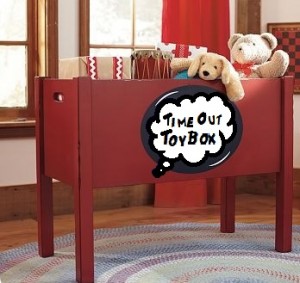 hit, drawn on, fought over, etc) and a gentle redirection has been given, the next step for the toy is to be put in the ‘Time-Out Toy Box.’ Little ones generally find the concept of a toy being put in Time-Out rather humorous and go along with the removal without a fuss (the toy can be returned after an exaggeratedly stern warning to the toy letting it know what is expected of it and that it must listen to ‘the boss’ ~the child, lol. They love that!), but remember to communicate, listen, and be flexible. If the removal of a toy brings about a strong negative response, it may be that the inappropriate behavior was more than just over-exuberance, in which case a Time-In might be needed. Again, being in tune with your child will help you to ‘read’ the situation and respond appropriately.
hit, drawn on, fought over, etc) and a gentle redirection has been given, the next step for the toy is to be put in the ‘Time-Out Toy Box.’ Little ones generally find the concept of a toy being put in Time-Out rather humorous and go along with the removal without a fuss (the toy can be returned after an exaggeratedly stern warning to the toy letting it know what is expected of it and that it must listen to ‘the boss’ ~the child, lol. They love that!), but remember to communicate, listen, and be flexible. If the removal of a toy brings about a strong negative response, it may be that the inappropriate behavior was more than just over-exuberance, in which case a Time-In might be needed. Again, being in tune with your child will help you to ‘read’ the situation and respond appropriately.
- The most challenging, independent children tend to be the ones who need the most intentional parental reconnection. Strong will=Strong need! It is often the strongest-willed children who identify most closely with their parents, oddly enough. While there is no denying how difficult it can be to raise a strong-willed child, seeing the purpose behind the behavior can make the journey much more manageable. Try to view their seemingly constant testing as them doing ‘research’ on you, seeing where your strengths and weaknesses are, and discovering all the ins and outs of being you. Also, taking the time to explain why you make the decisions you do, why you said this, why you didn’t say that, answering the endless questions patiently and openly, can alleviate some of the challenging behavior by offering them insights into who you are without them having to ‘dig’ it out of you!
Related posts:
Practical, Gentle, Effective Discipline
The Taming of the Tantrum: A Toddler’s Perspective
When Children Hit~10 Tips for Parents
Easy Peasy DIY Parenting Tools
To a Toddler Sharing is a 4 Letter Word~MINE!
Tots to Teens~Communication through the Ages and Stages
Parenting in Public: Toddler Time
 Award-winnning author, L.R.Knost, is the founder and director of the children's rights advocacy and family consulting group, Little Hearts/Gentle Parenting Resources, and Editor-in-Chief of Holistic Parenting Magazine. Books by L.R.Knost include Whispers Through Time: Communication Through the Ages and Stages of Childhood ; Two Thousand Kisses a Day: Gentle Parenting Through the Ages and Stages ; The Gentle Parent: Positive, Practical, Effective Discipline ; and Jesus, the Gentle Parent: Gentle Christian Parenting the first four books in the Little Hearts Handbook gentle parenting series, and children’s picture books Petey’s Listening Ears and the soon-to-be-released Grumpykins series.
Award-winnning author, L.R.Knost, is the founder and director of the children's rights advocacy and family consulting group, Little Hearts/Gentle Parenting Resources, and Editor-in-Chief of Holistic Parenting Magazine. Books by L.R.Knost include Whispers Through Time: Communication Through the Ages and Stages of Childhood ; Two Thousand Kisses a Day: Gentle Parenting Through the Ages and Stages ; The Gentle Parent: Positive, Practical, Effective Discipline ; and Jesus, the Gentle Parent: Gentle Christian Parenting the first four books in the Little Hearts Handbook gentle parenting series, and children’s picture books Petey’s Listening Ears and the soon-to-be-released Grumpykins series.

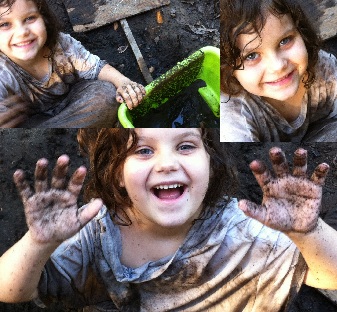


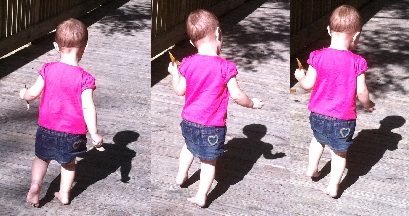

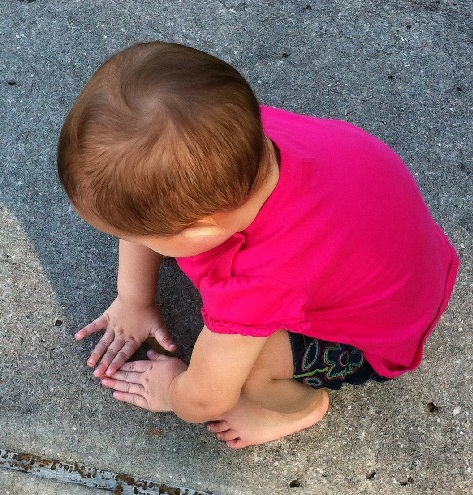
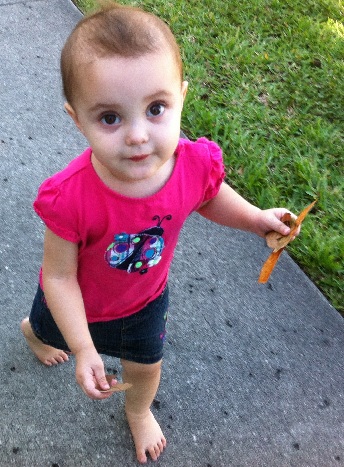
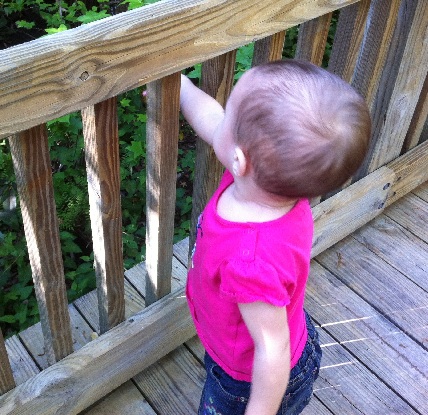

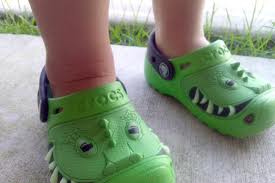



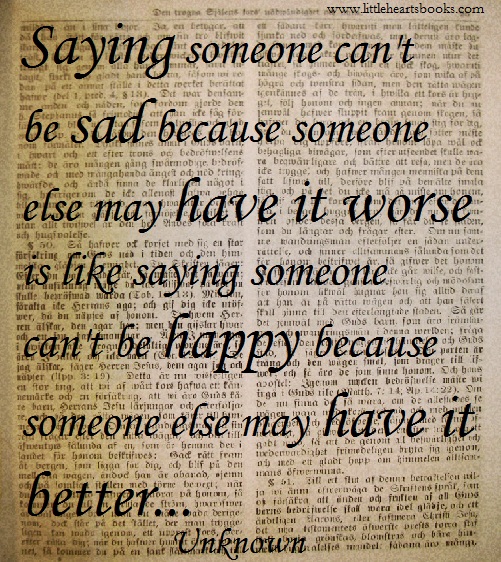
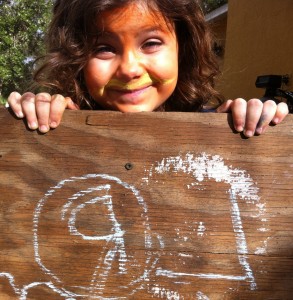
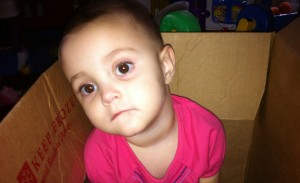

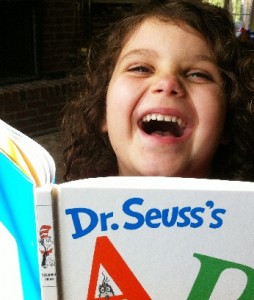

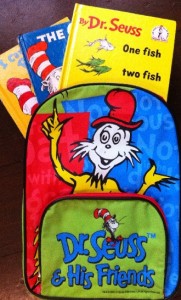


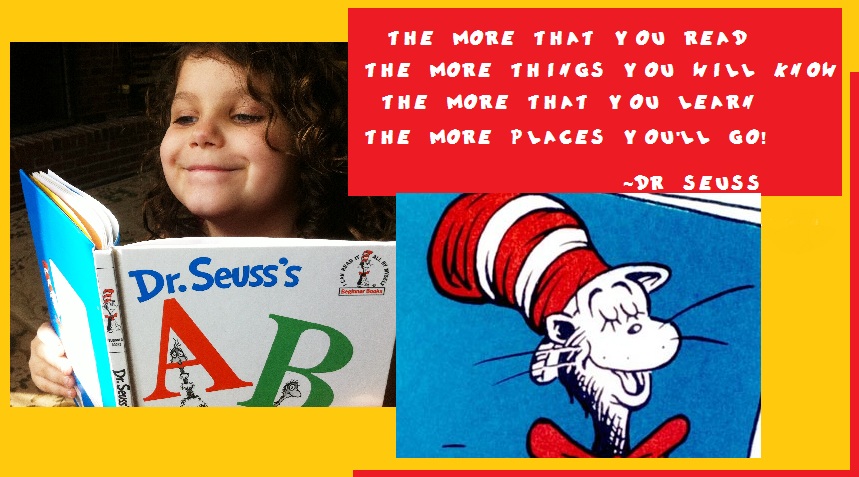




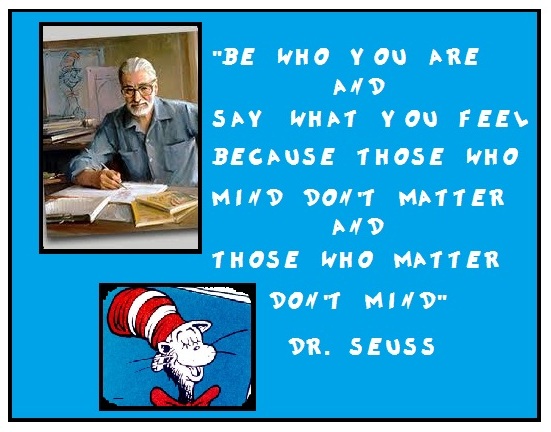
 There is such a rush these days to get children sleeping through the night, weaned off the breast, eating solid foods, potty trained, reading independently, and on and on, that we seem to have lost the ability to simply enjoy life as it happens and let our children do the same. Gone are the days of making mud-pies and playing in piles of leaves. They’ve been replaced with flashcards, language immersion (even in the womb!), educational dvd’s, and the like. Preschool has become the new kindergarten, with parents rushing to get on waiting lists for the ‘best of the best’ preschools, often even before their first prenatal appointment!
There is such a rush these days to get children sleeping through the night, weaned off the breast, eating solid foods, potty trained, reading independently, and on and on, that we seem to have lost the ability to simply enjoy life as it happens and let our children do the same. Gone are the days of making mud-pies and playing in piles of leaves. They’ve been replaced with flashcards, language immersion (even in the womb!), educational dvd’s, and the like. Preschool has become the new kindergarten, with parents rushing to get on waiting lists for the ‘best of the best’ preschools, often even before their first prenatal appointment!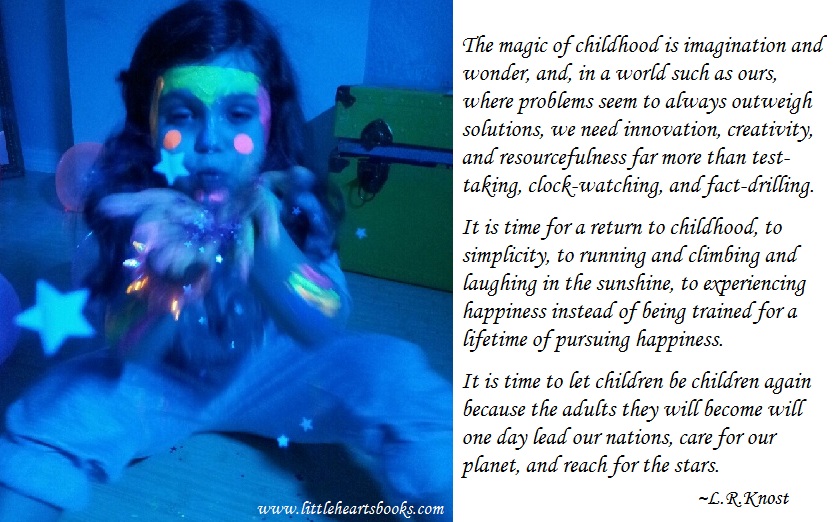

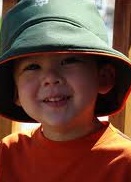
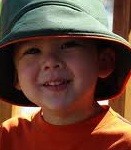

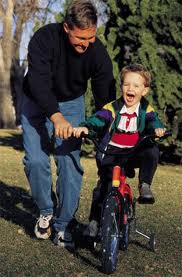 Think of learning to ride a bicycle.
Think of learning to ride a bicycle.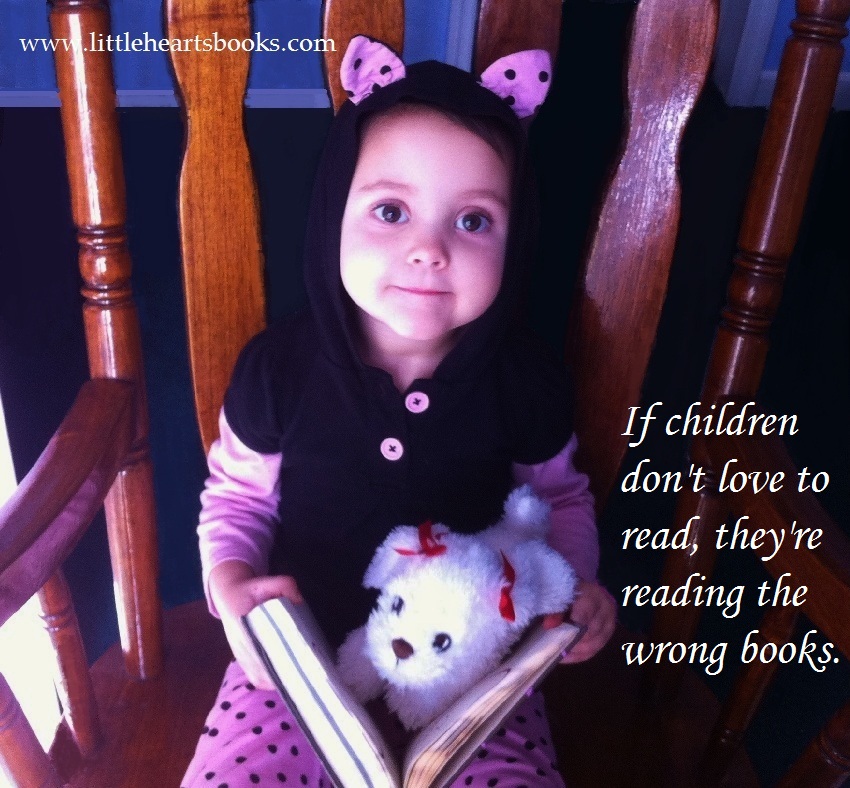 When it comes to reading, do you want your children to become readers or just learn the mechanics of reading? Do you want them to love to read or just know how? If a love of reading is your goal for your children, here are some ideas to get you started:
When it comes to reading, do you want your children to become readers or just learn the mechanics of reading? Do you want them to love to read or just know how? If a love of reading is your goal for your children, here are some ideas to get you started:
